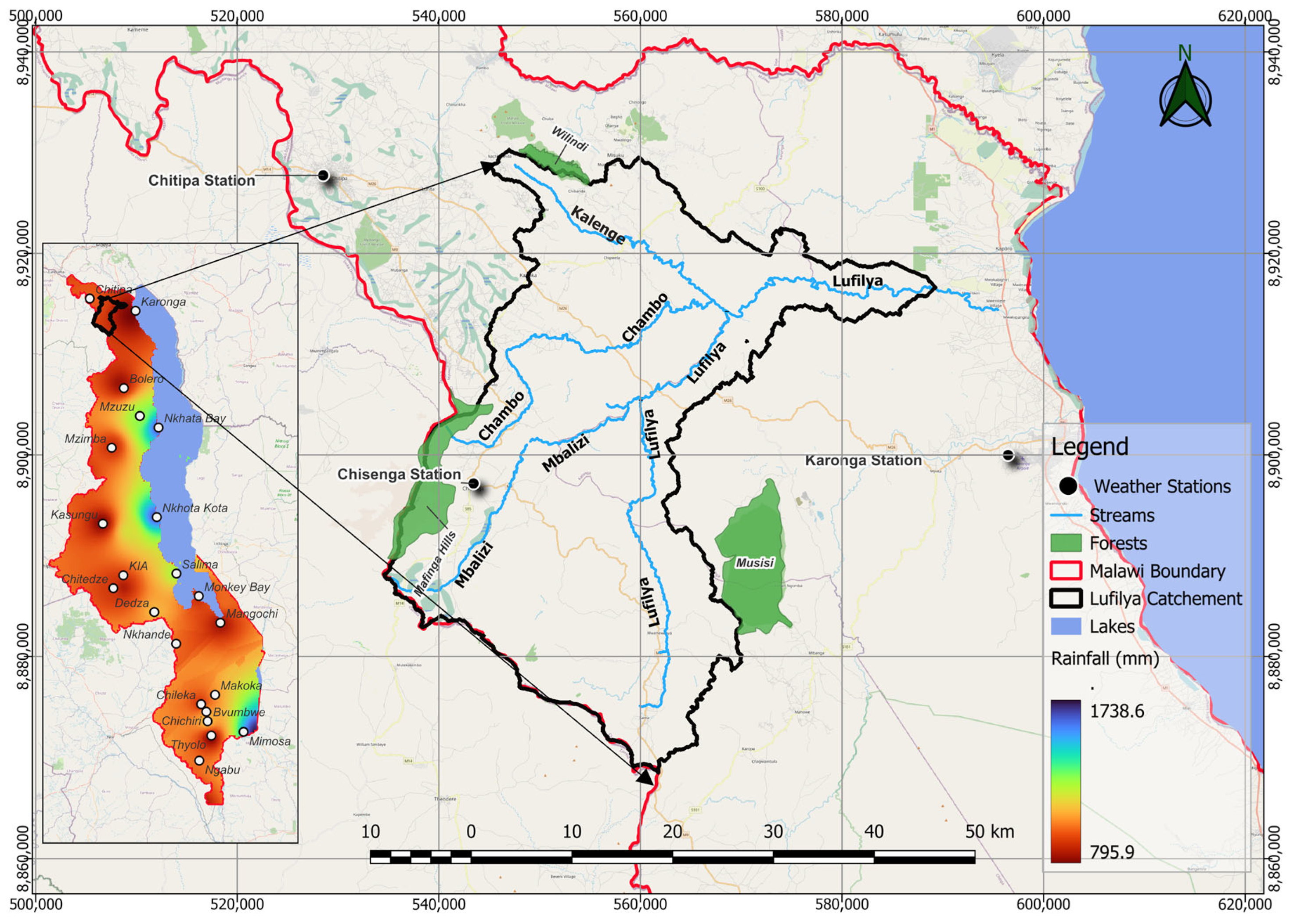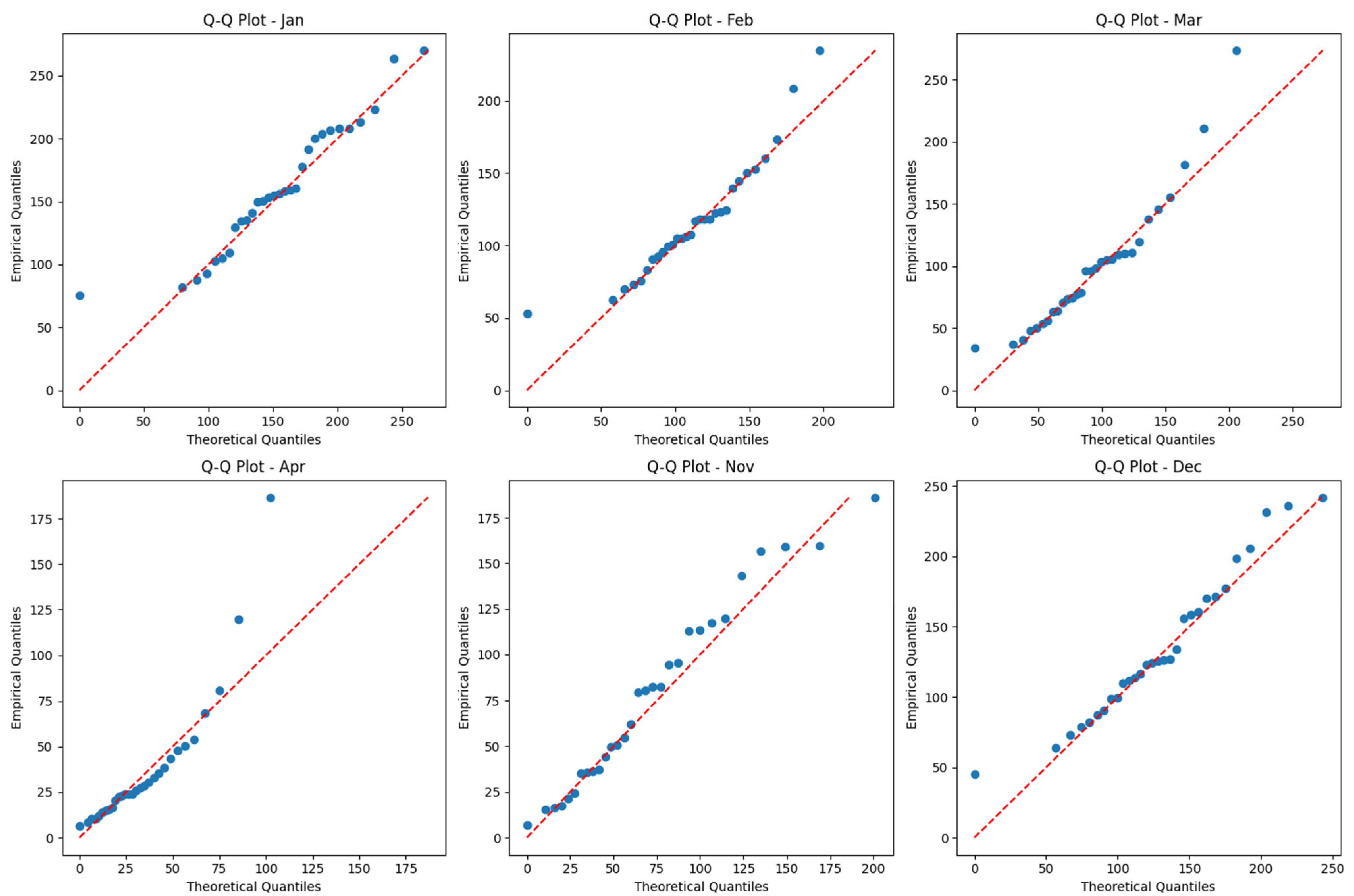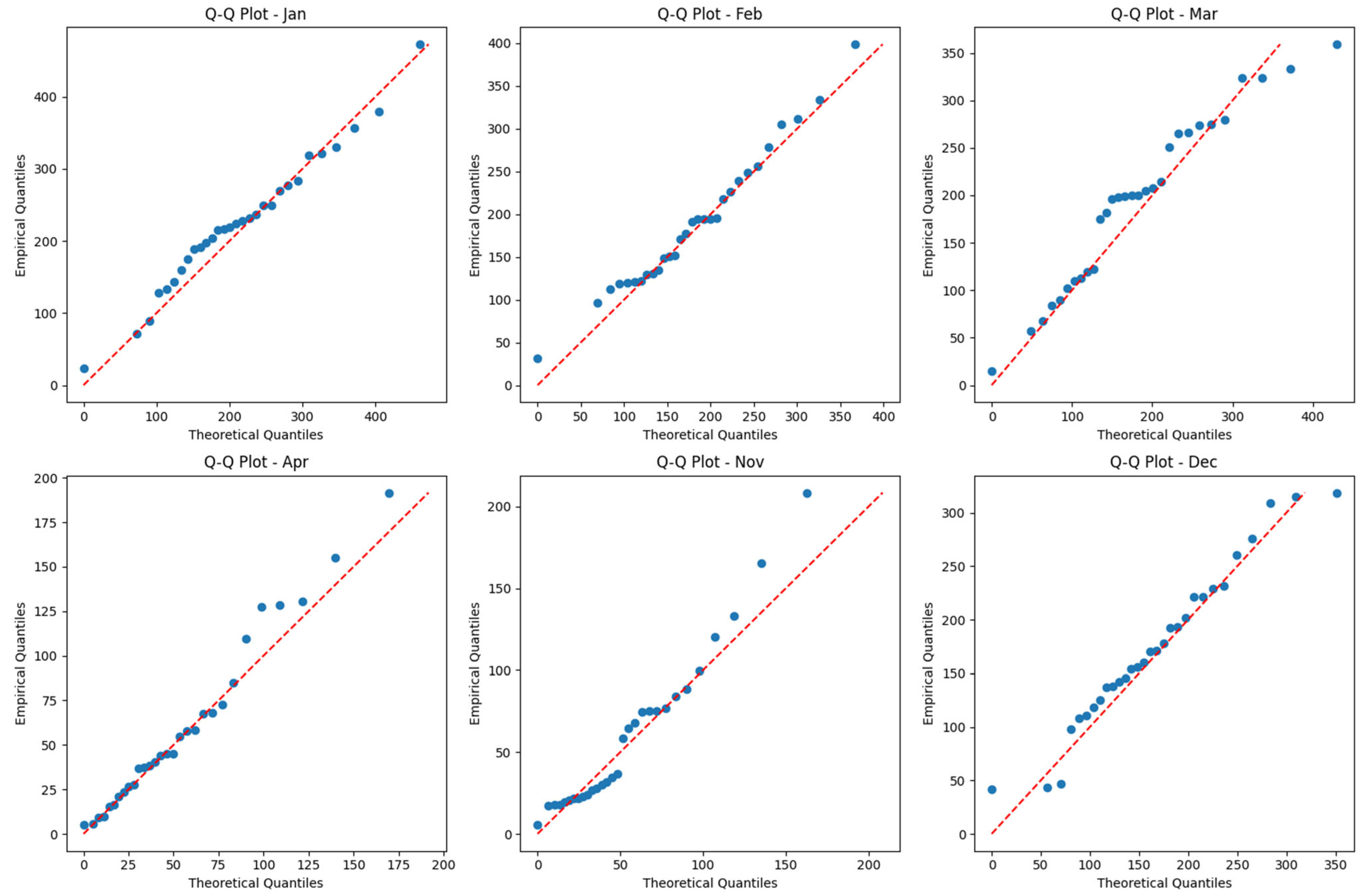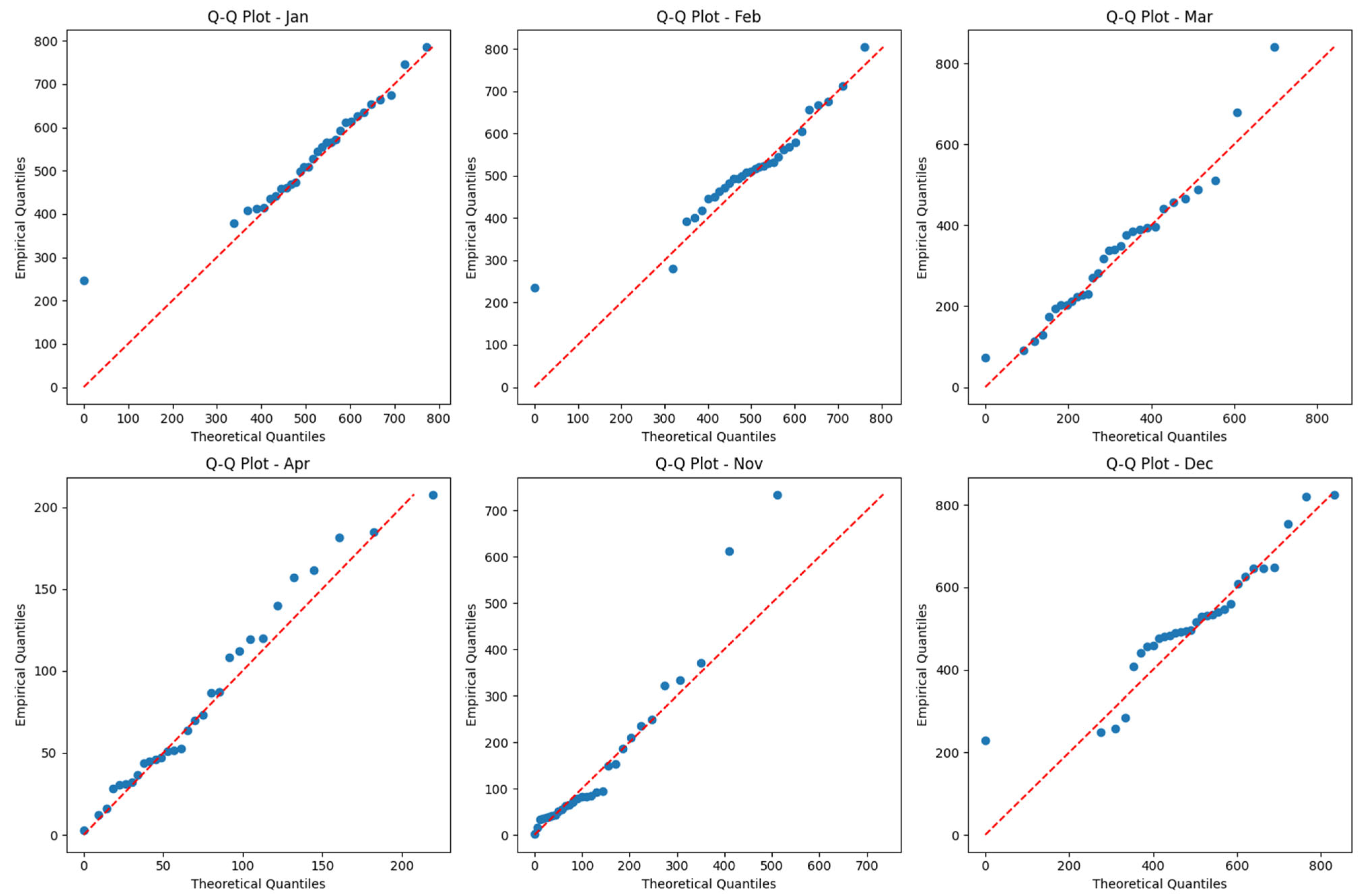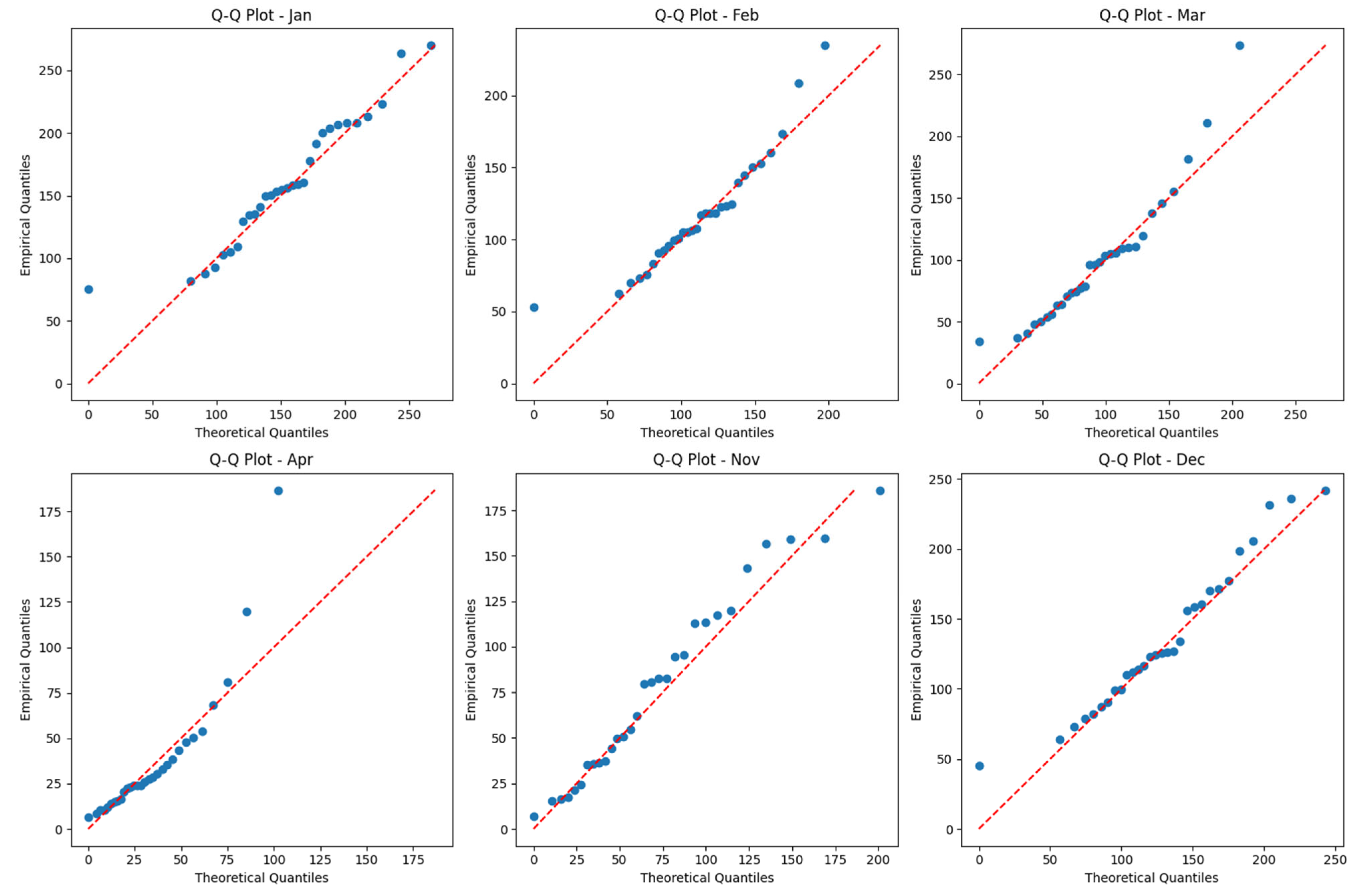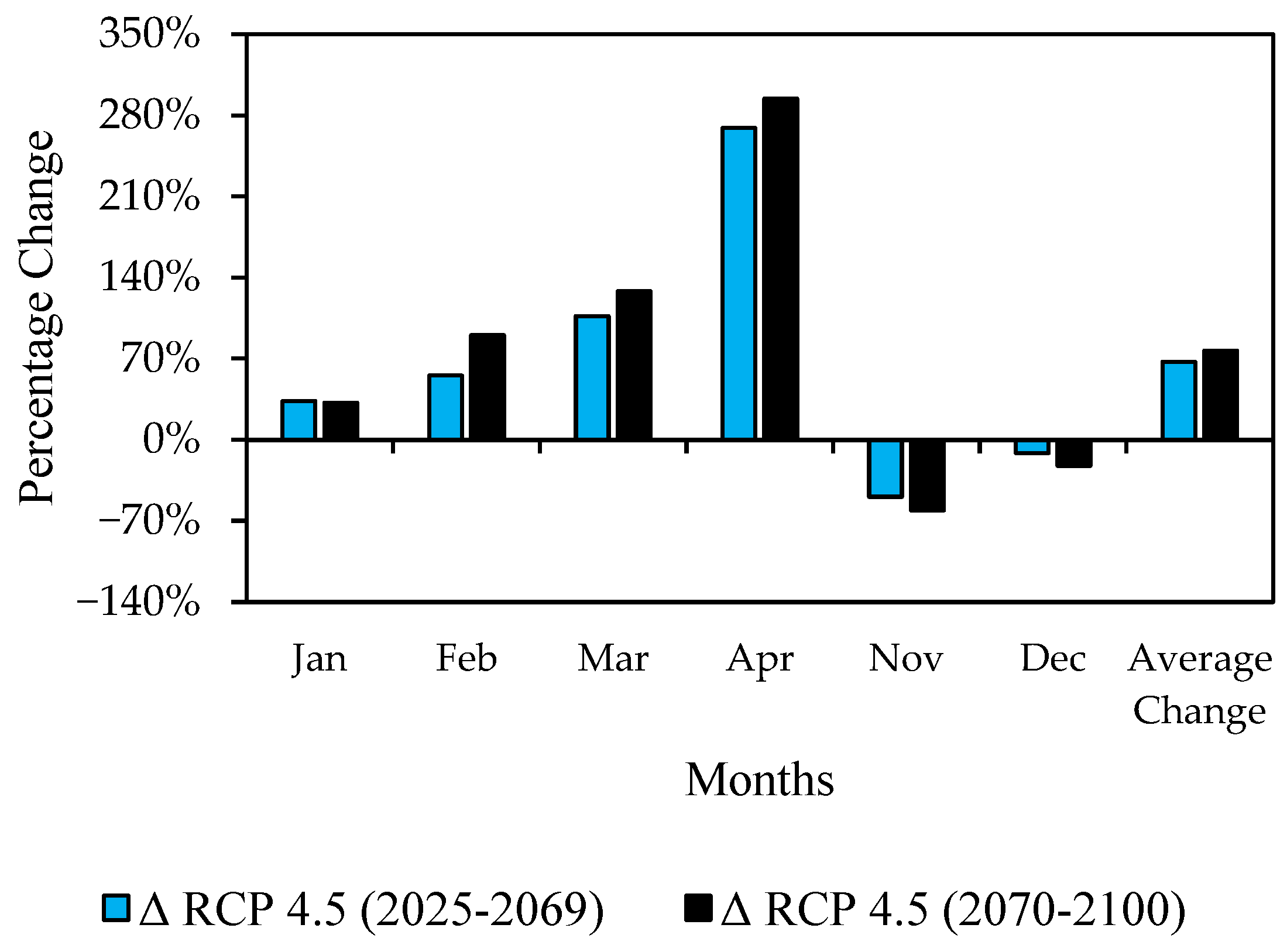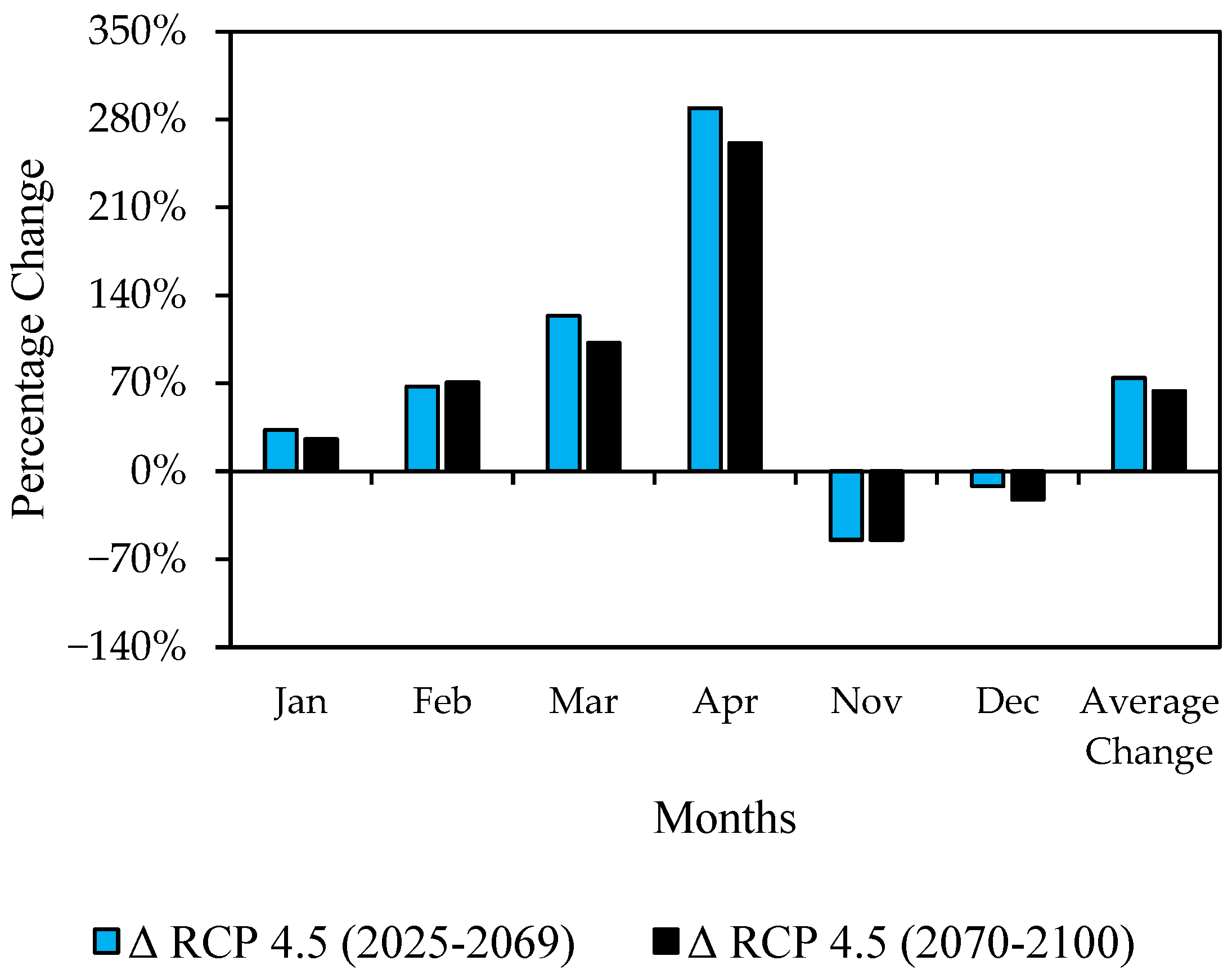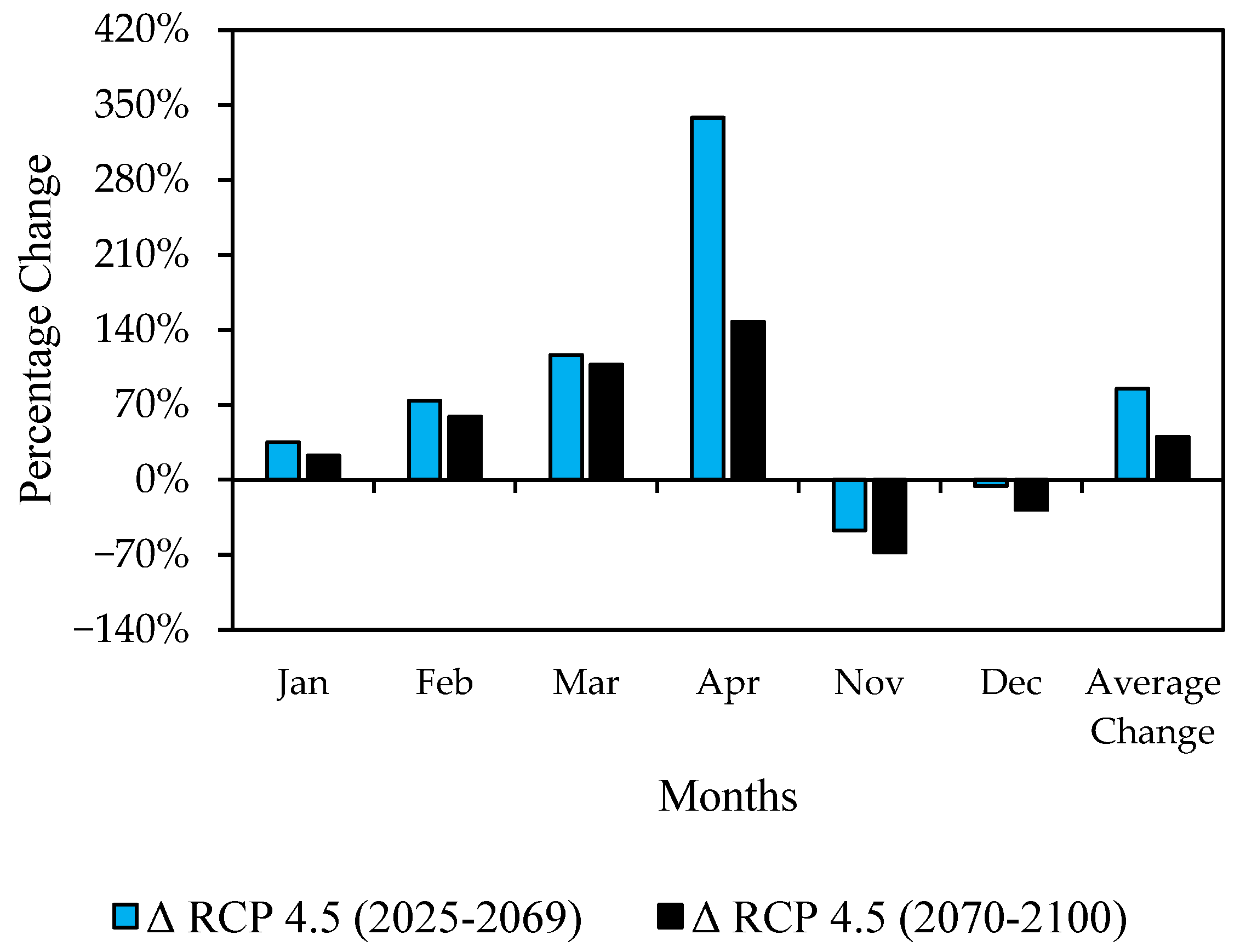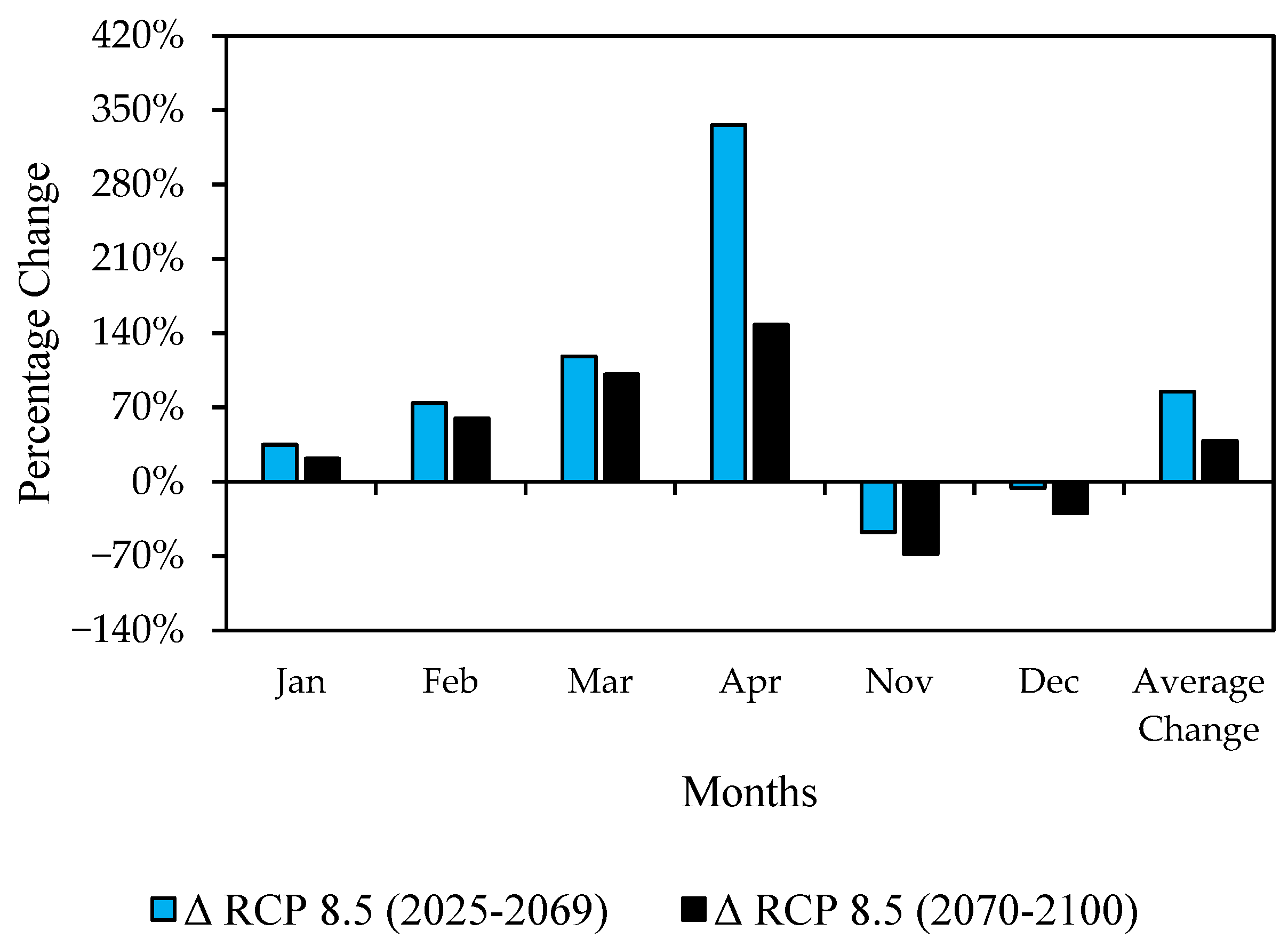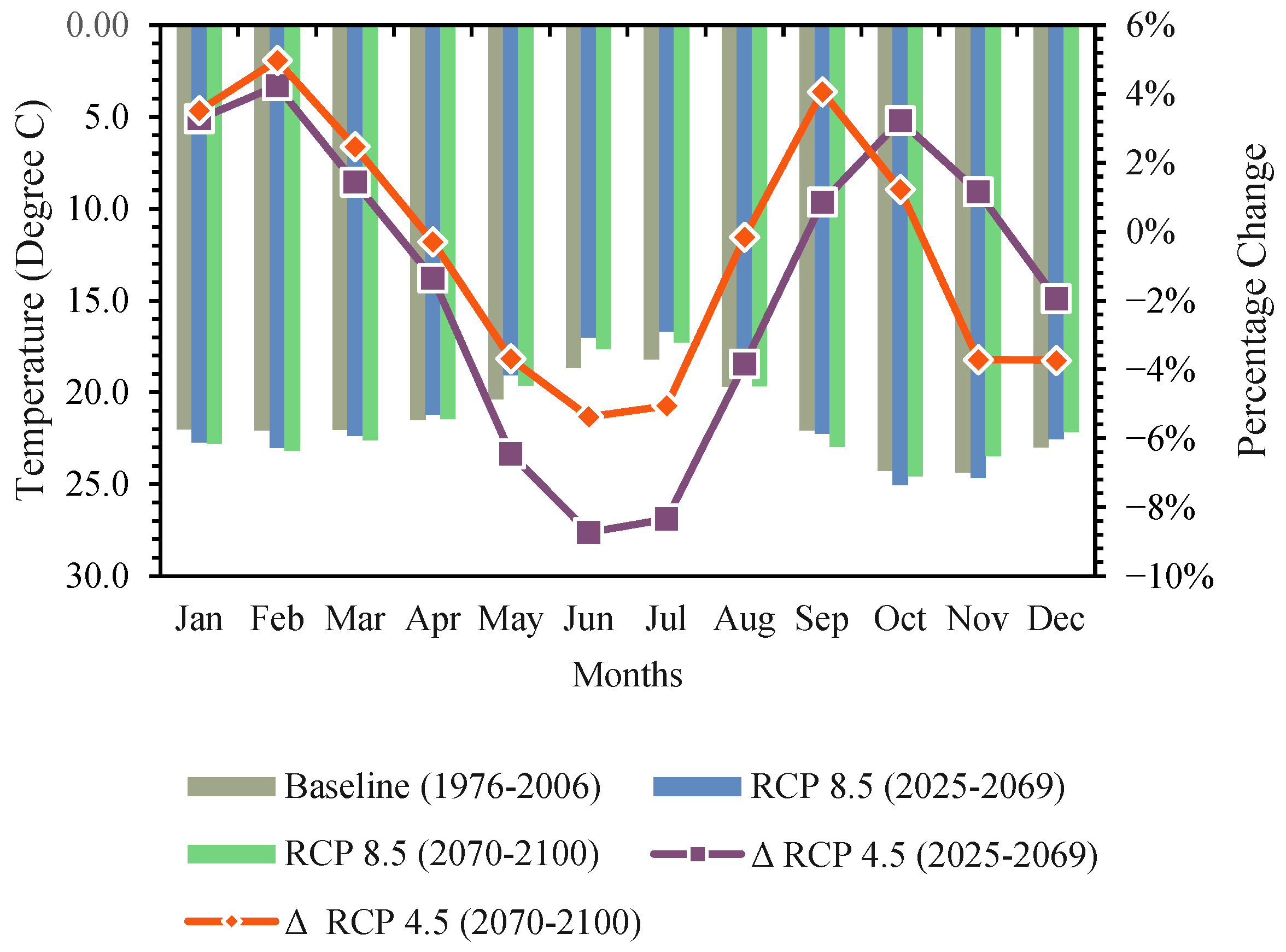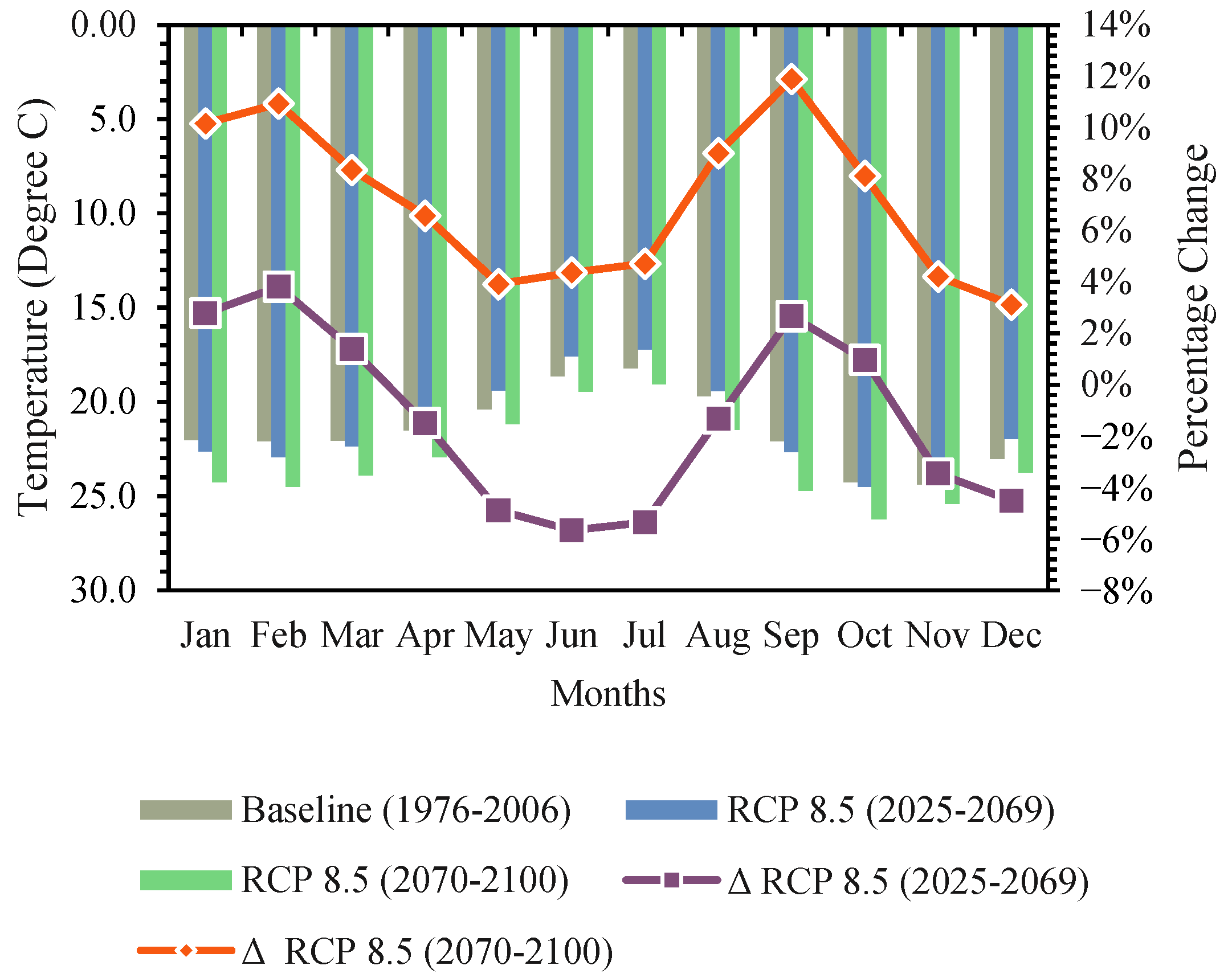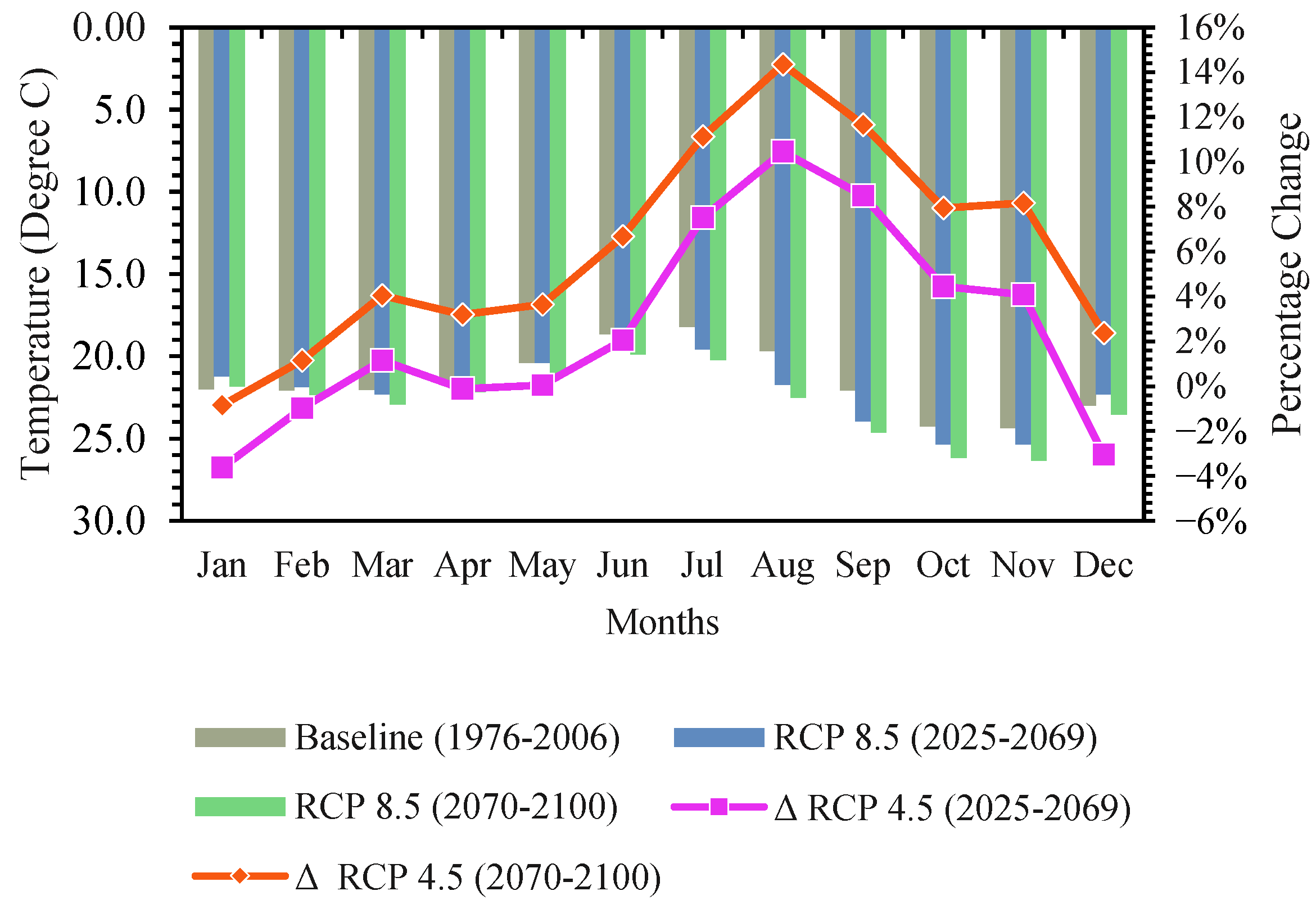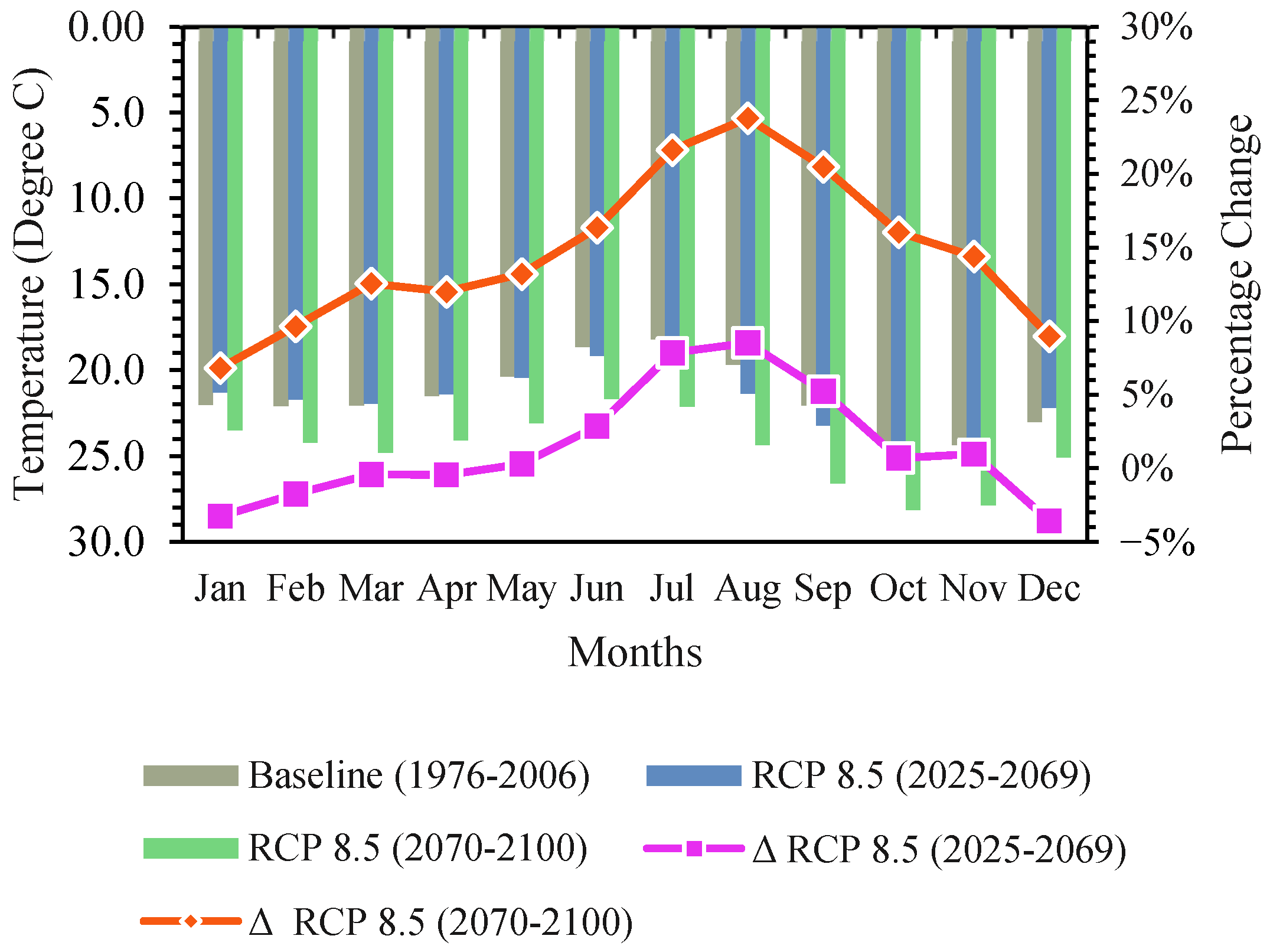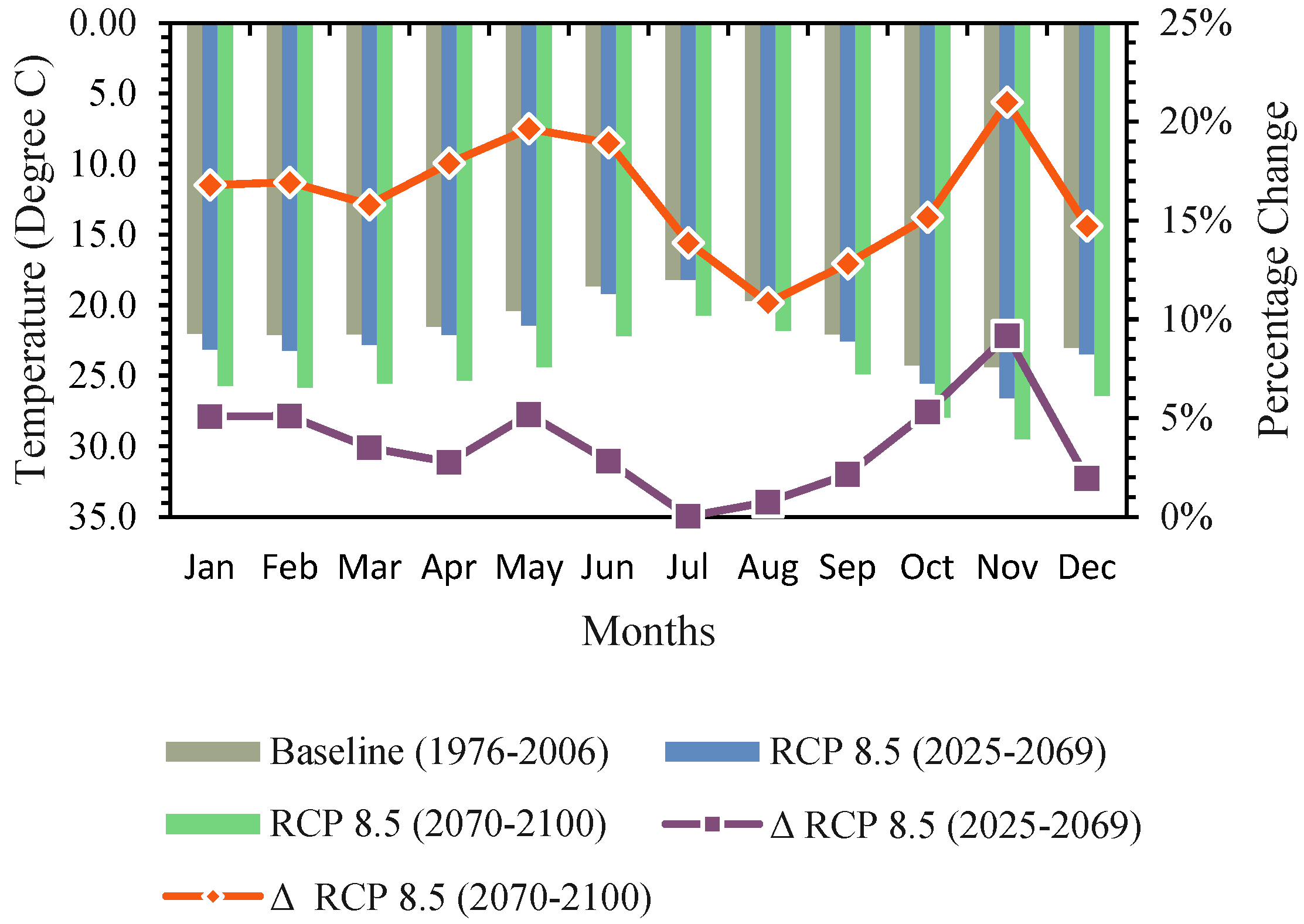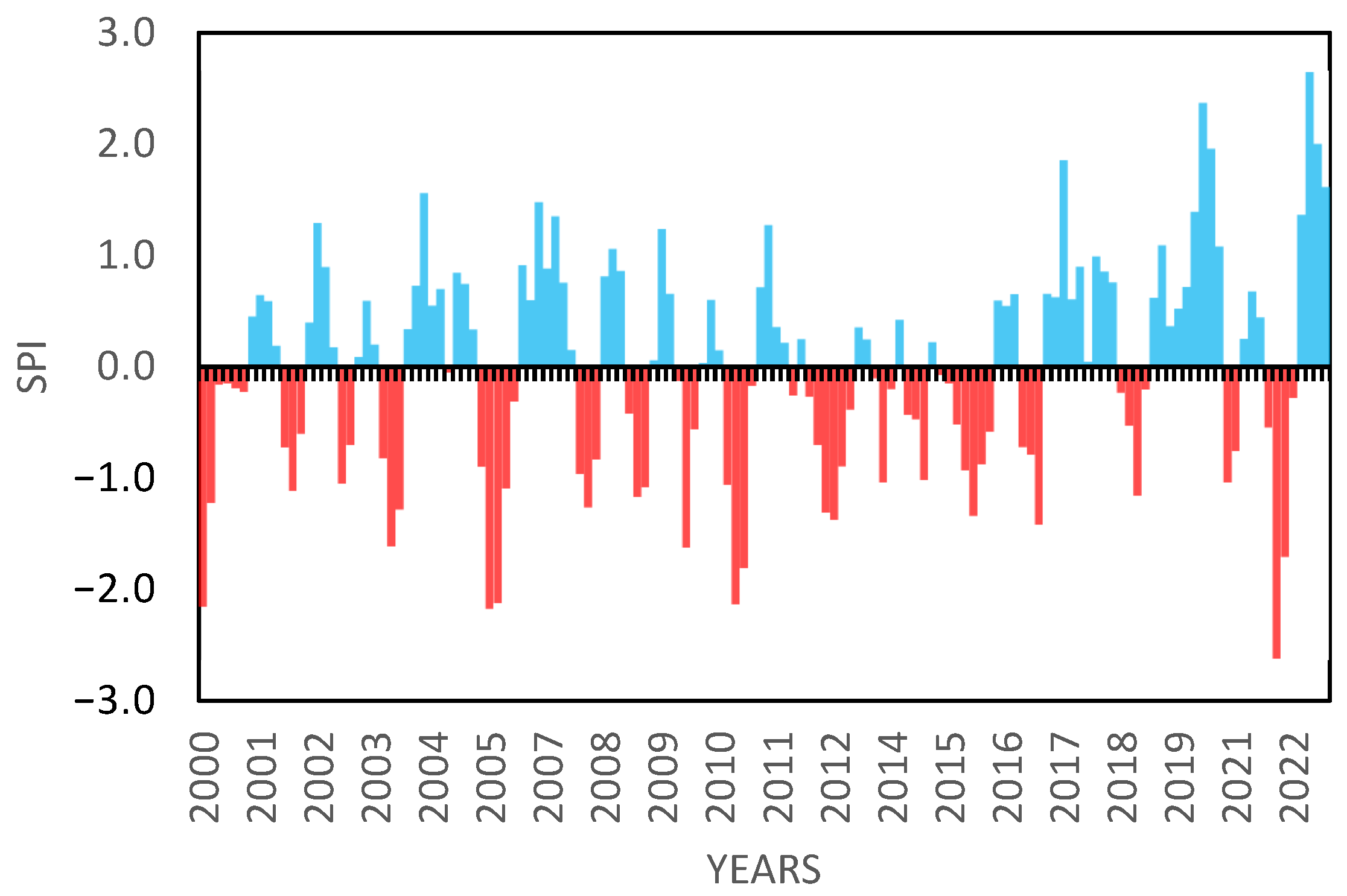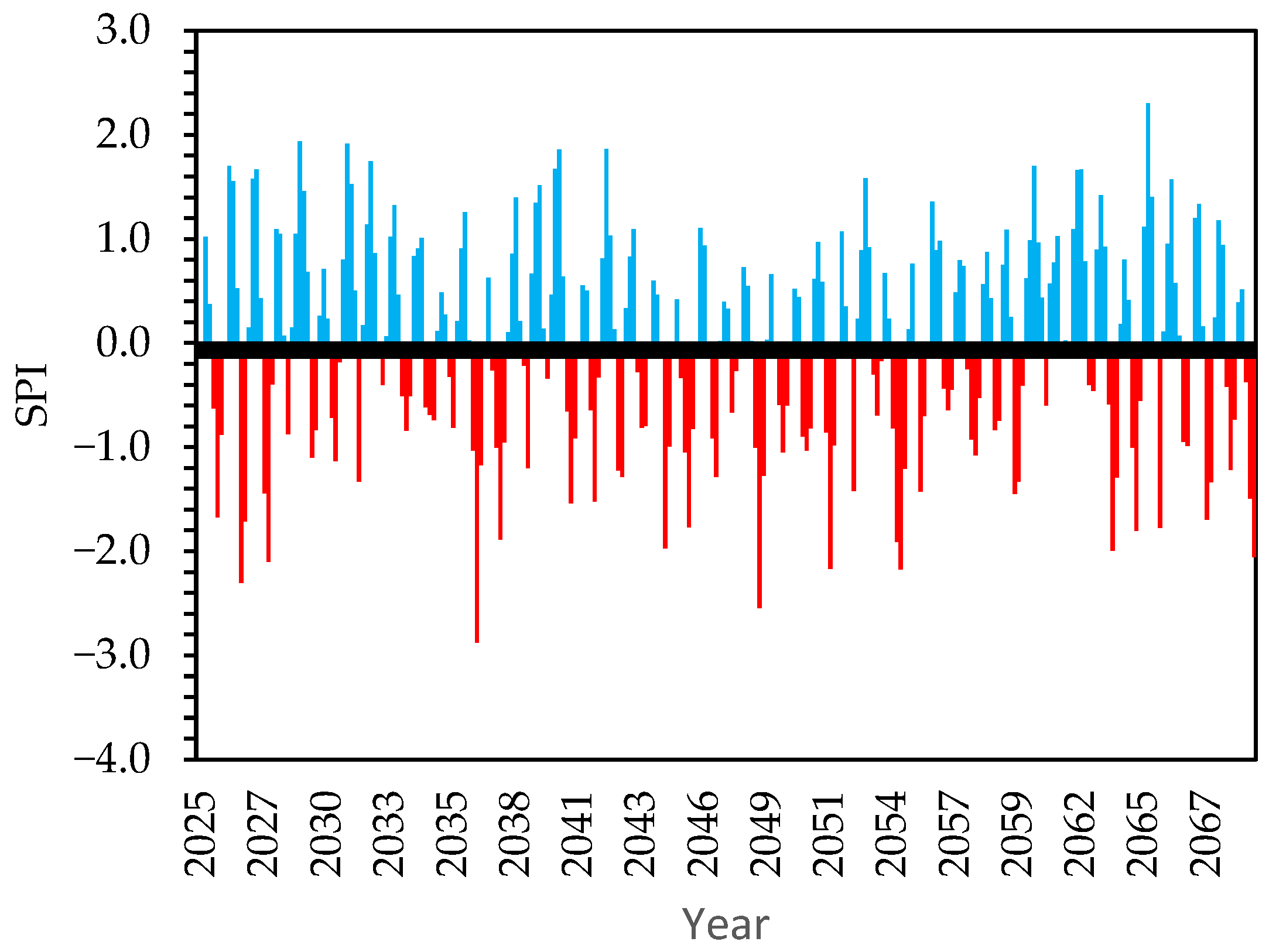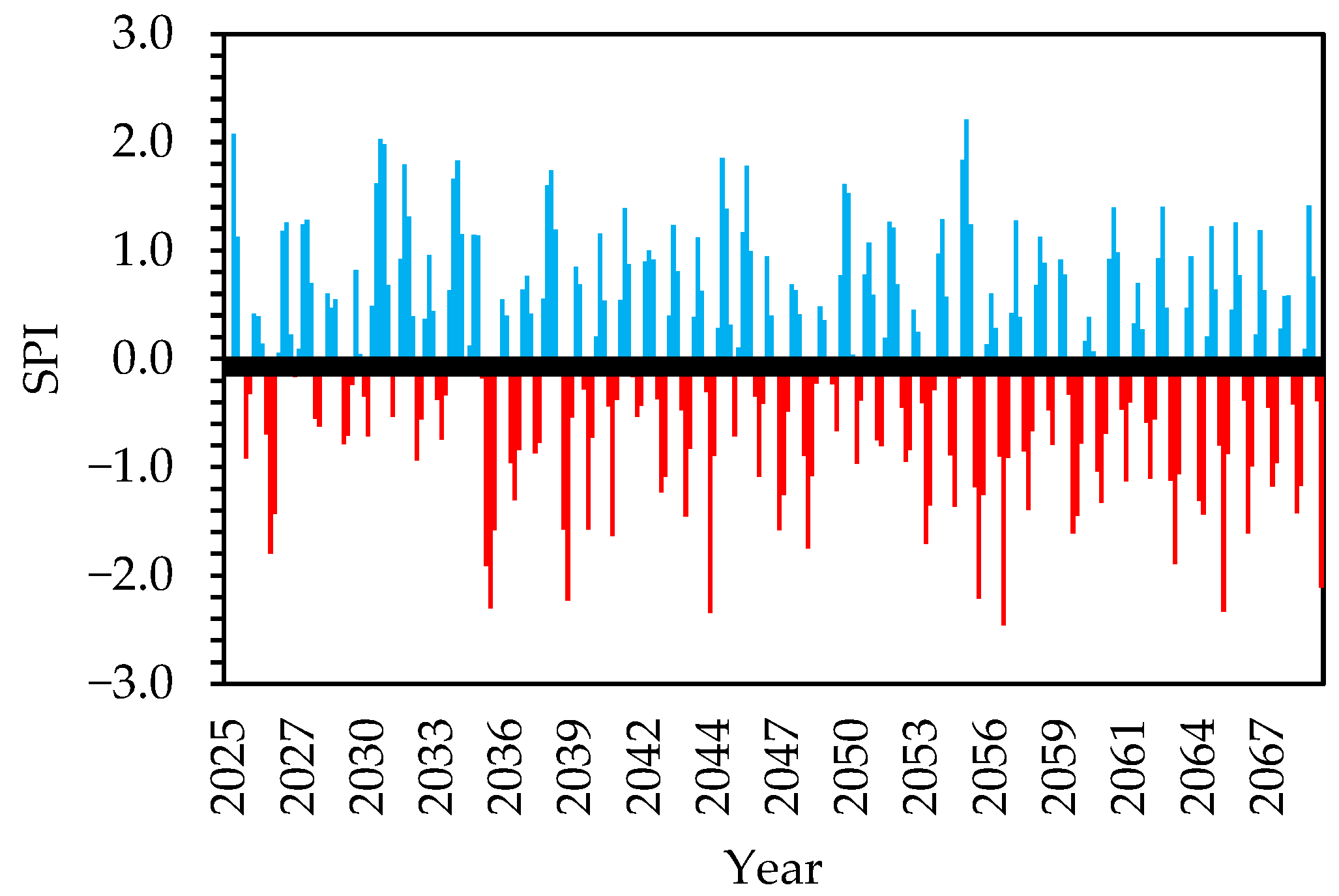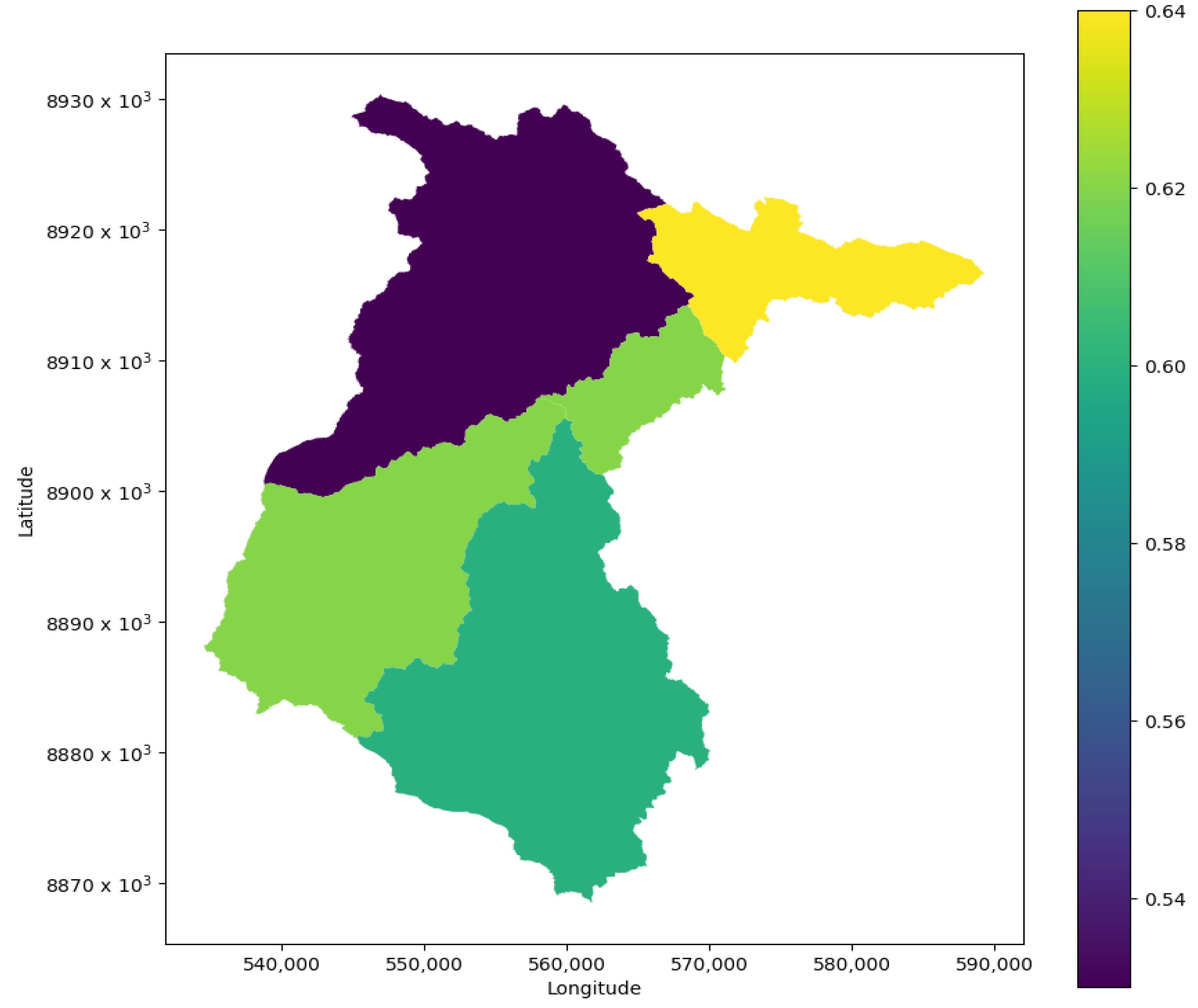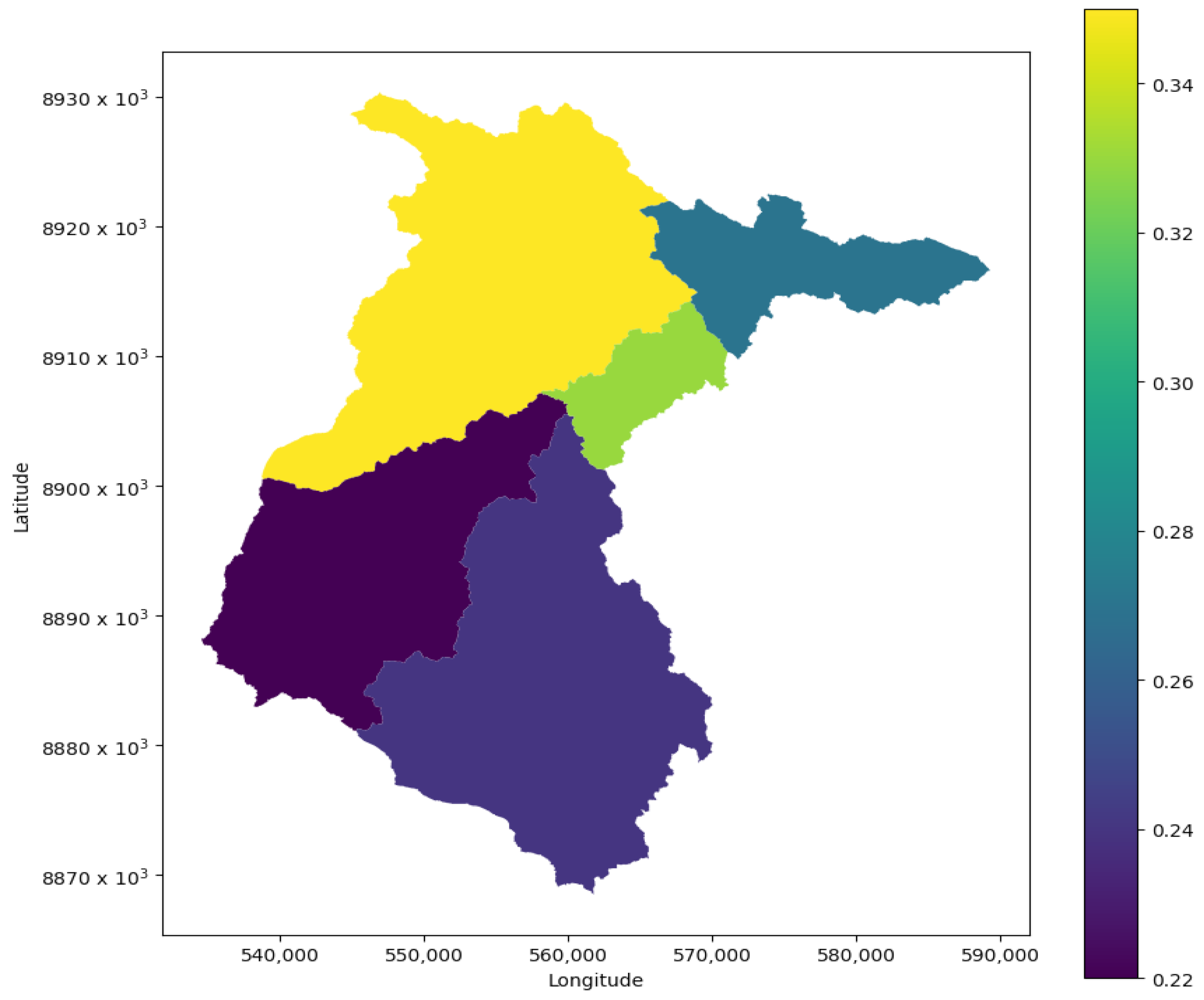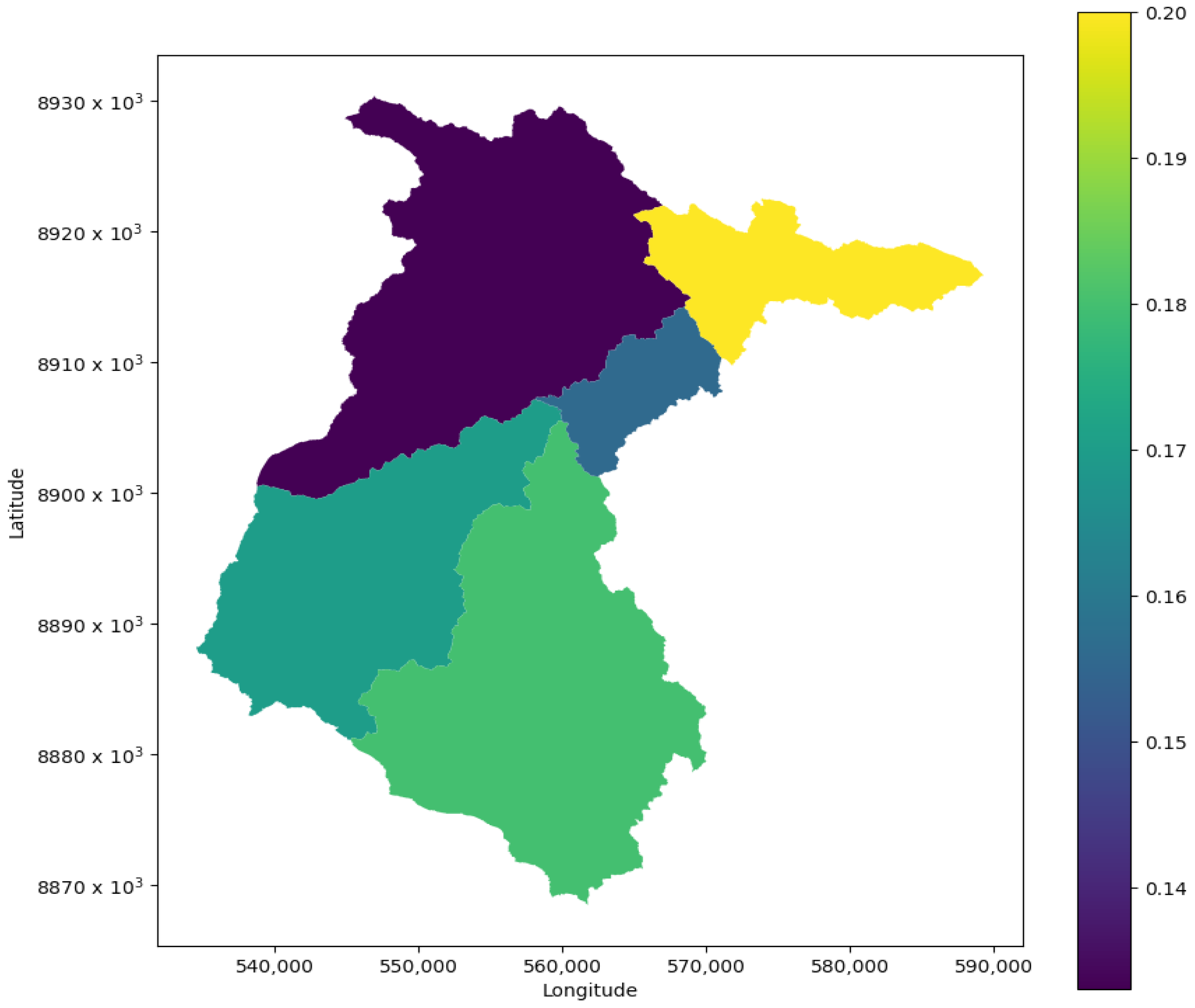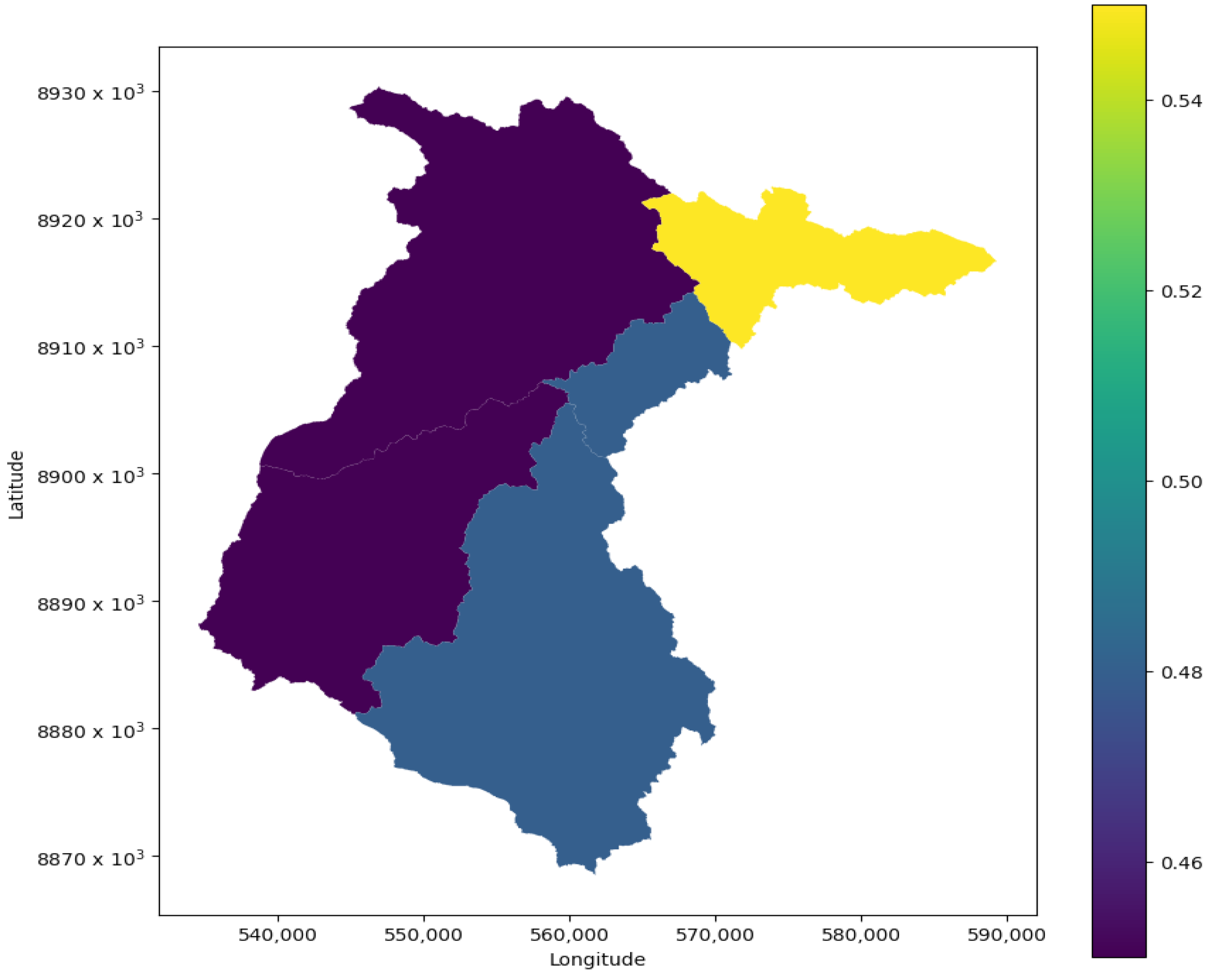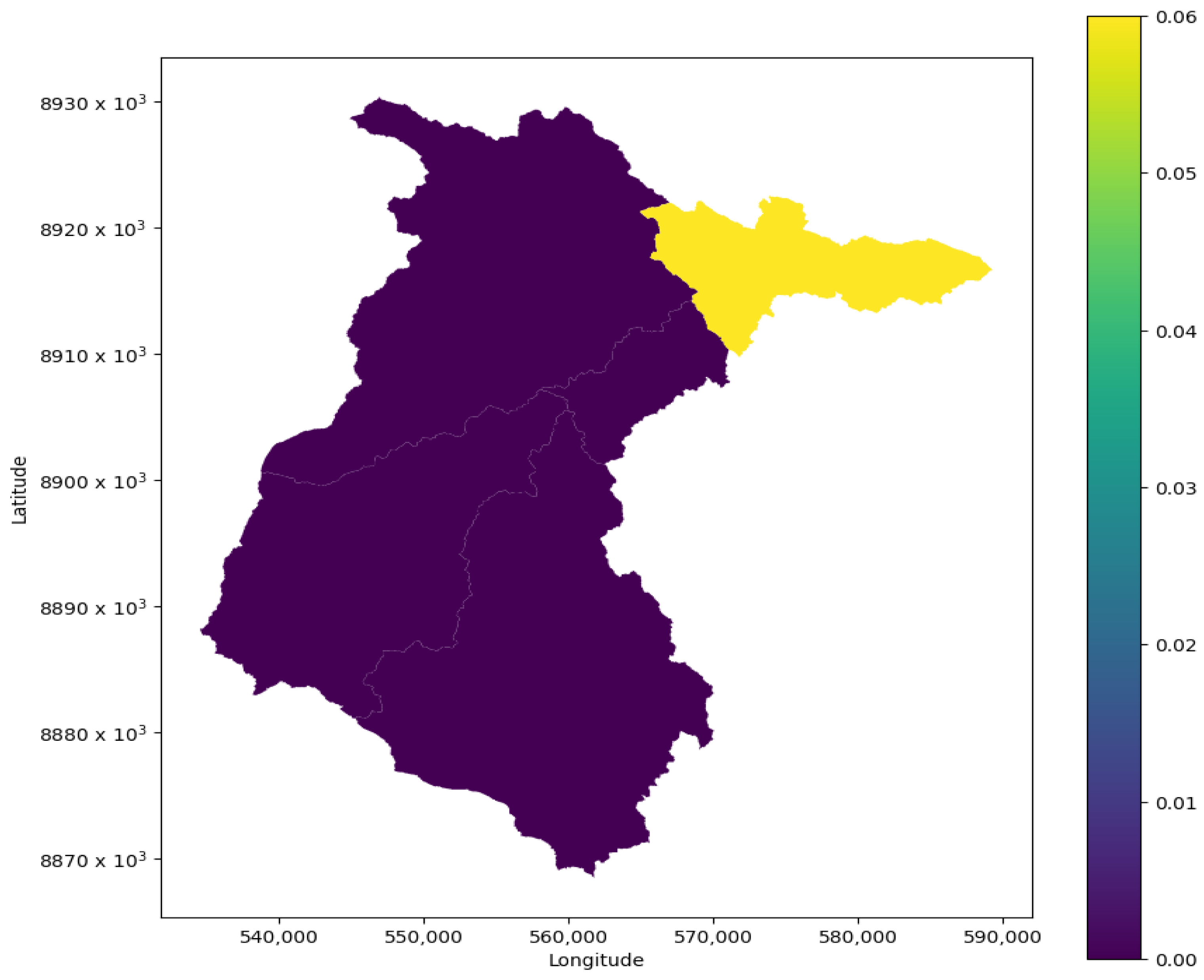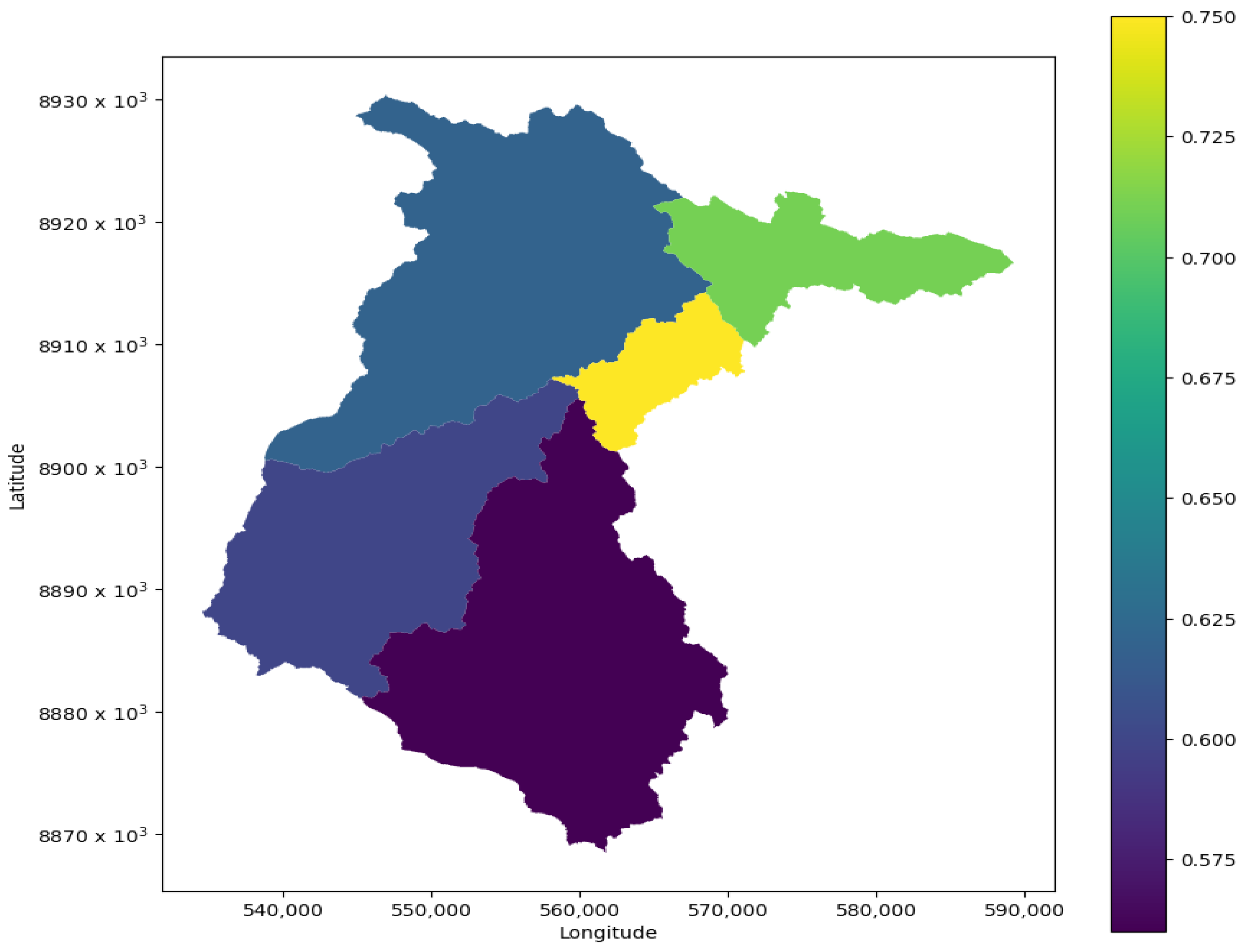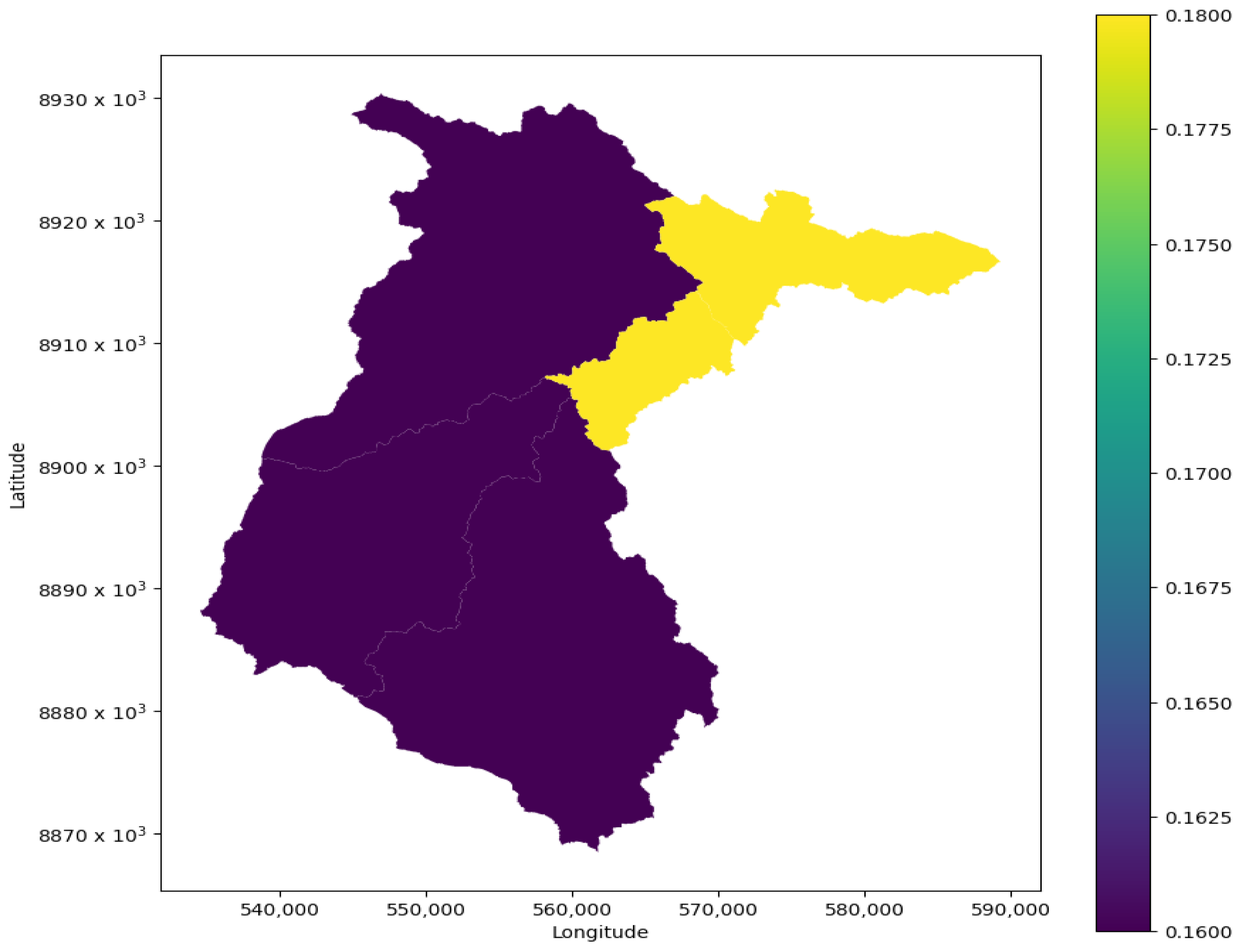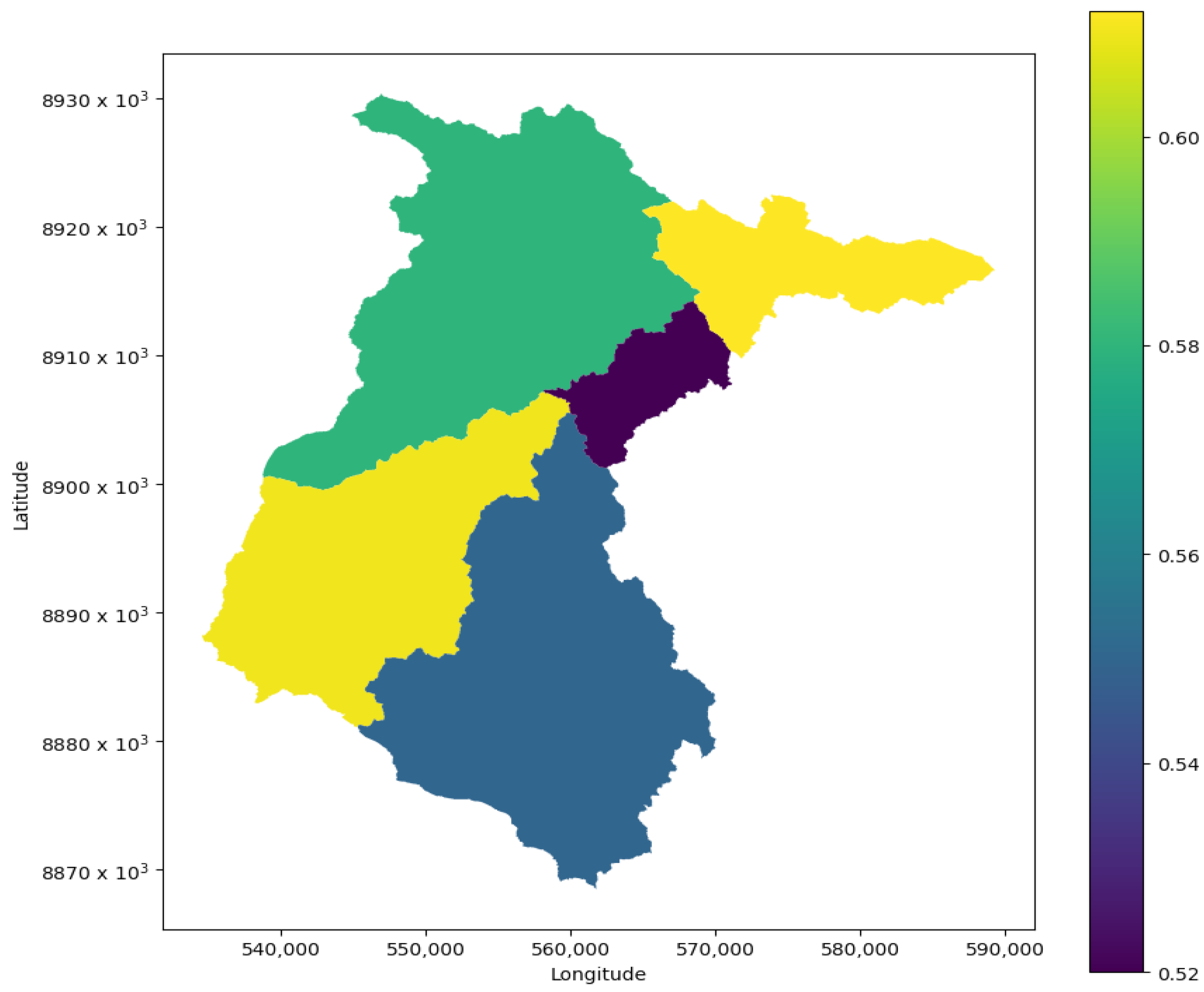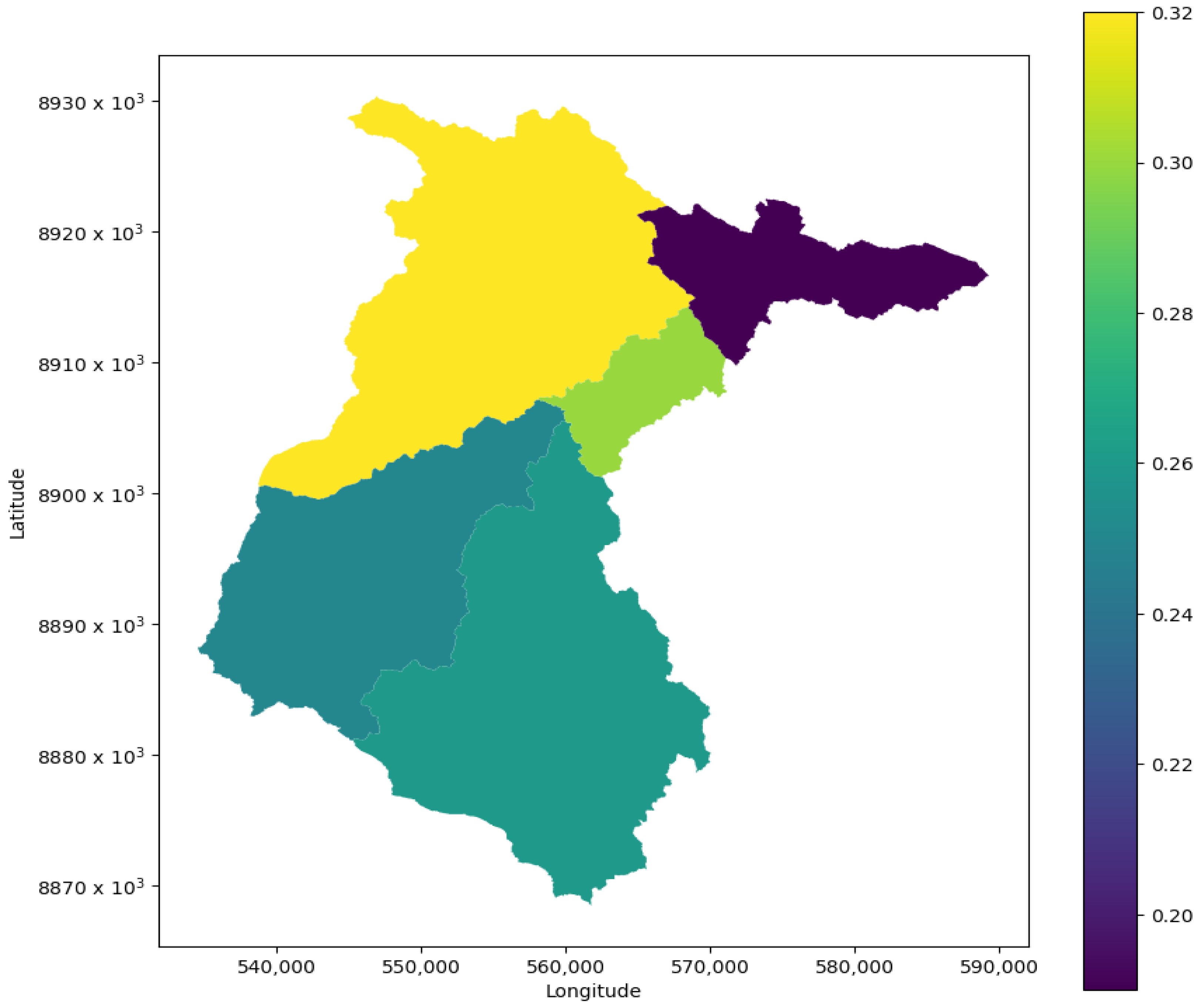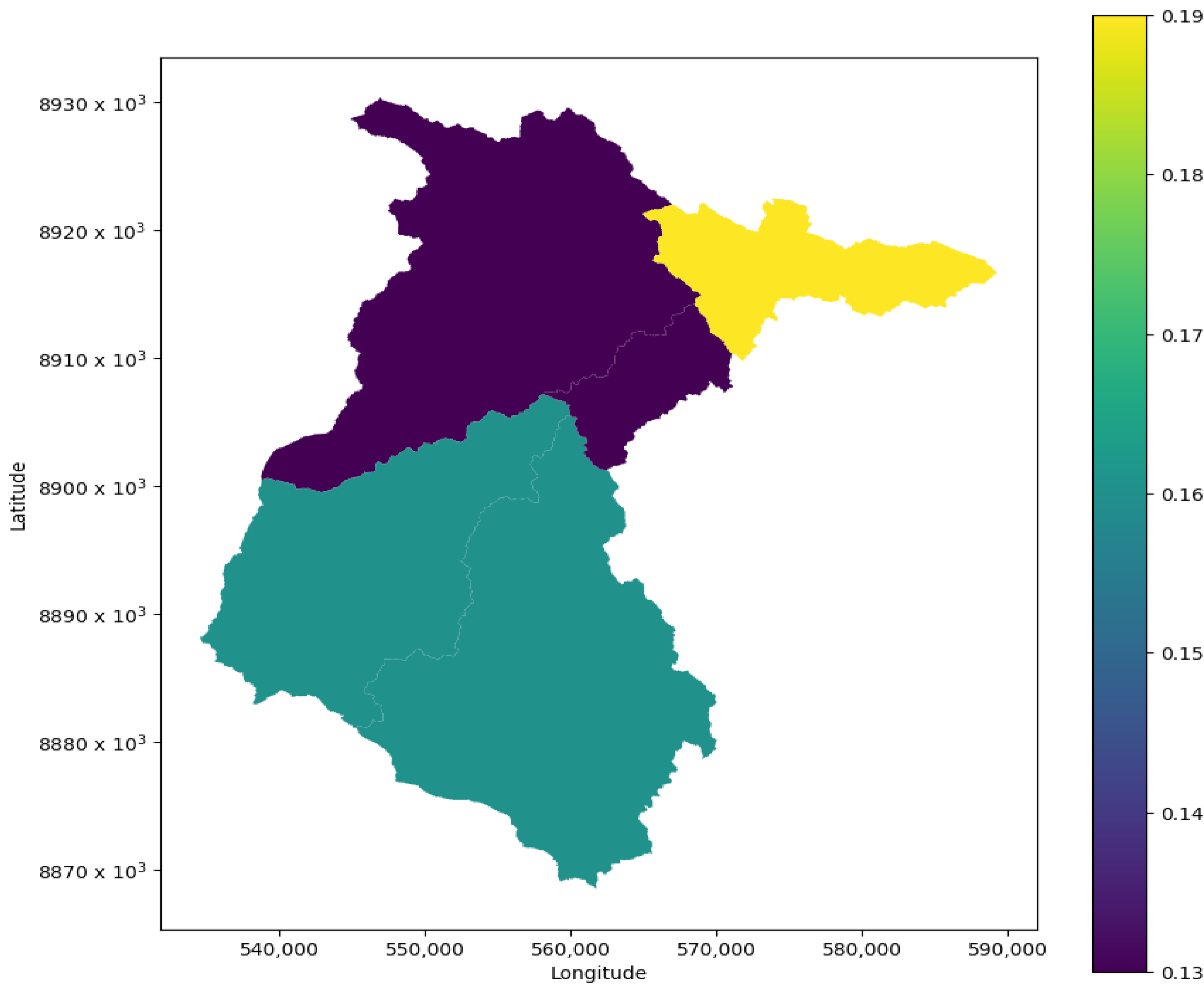1. Introduction
Drought is one of the most devastating forms of water stress, alongside floods, in this century [
1]. This phenomenon has led to various negative impacts on the social and economic well-being of people [
2]. Generally, drought is defined as a deficiency in the quantity of water relative to normal requirements [
3]. Despite the complex nature of droughts [
3] and the lack of general consensus on its definition, Liu et al. [
4] and Wu et al. [
5] have categorized droughts into meteorological, hydrological, agricultural, and socio-economic types. Meteorological drought results from a significant negative deviation in precipitation from the long-term average normally received in an area [
6,
7]. Hydrological drought refers to the reduction in streamflow or groundwater below normal levels, affecting ecosystems dependent on these water sources [
2]. Agricultural drought results from a deficiency in soil moisture and water levels below which crops and domestic animals can survive, thus compromising agricultural productivity [
8].
Meteorological drought is the initial precursor to the other types, as a prolonged shortage of precipitation leads to insufficient soil moisture and reduced river flows, consequently resulting in agricultural and hydrological droughts [
9].
Regarding the destructive effects of droughts, researchers have attempted to predict and model drought using various mathematical indicators. However, all these methods exhibit some uncertainty in accurately predicting drought [
10]. The most notable indicators include the Standardized Precipitation Index (SPI), the Standardized Precipitation and Evapotranspiration Index (SPEI), the Palmer Drought Index (PDI), and the Streamflow Drought Index (SDI) [
10]. Agricultural drought is mostly indicated by soil moisture percentiles [
11]. Apart from analyzing the variability and cumulative effects of droughts, these drought indicators have been used to examine the onset, return periods, and propagation of droughts [
5].
Among these indicators, the SPI is the most commonly used due to its simplicity and flexibility in utilizing rainfall data on a monthly temporal scale [
10,
12]. Consequently, many researchers in Africa have focused on it in their studies. For example, Oguntunde et al. [
13] used the SPI, SPEI, and SDI to quantify drought characteristics in the Volta Basin in West Africa. Khoi et al. [
12] used SPI and SDI to assess the impacts of climate change on hydro-meteorological drought, and Jayanthi et al. [
14] used SPI to model the vulnerability of rain-fed maize to persistent droughts.
Under the influence of climate change, drought prevalence has been exacerbated by climate-induced hydrological extremes [
5]. According to IPCC [
15], it is likely that most parts of the world will experience more frequent drought conditions in the future due to climate change. Therefore, investigations into the impacts of climate change are essential and urgently needed [
16,
17]. In the context of climate change, global temperatures are projected to increase above pre-industrial levels, while rainfall patterns are expected to become more erratic worldwide [
18,
19].
To ascertain the future distribution and occurrence of droughts, researchers have applied drought indicators to future meteorological data simulated by Global Circulation Models (GCMs) and downscaled Regional Climate Models (RCMs), using various Representative Concentration Pathways (RCPs). For instance, Wu et al. [
5] used future meteorological data simulated by 15 different GCMs to analyze the influence of global warming on drought propagation. They found that most African and Asian countries are likely to experience more droughts in the future. Similarly, Khoi et al. [
12] used five GCMs for future climate projections and found that while drought severity is projected to decrease, their frequency is expected to increase. Conversely, Mahdavi et al. [
20] used the Long Ashton Research Station Weather Generator (LARS-WG) to simulate future climate, which was then subjected to SPI and SDI to project drought prevalence. Their study projected no severe meteorological droughts in the future, although one severe hydrological drought was expected. Additionally, Won and Kim [
21] used RCMs to predict future drought severity, finding that SPI indicated no severe droughts, but the Evaporative Demand Drought Index (EDDI) projected severe floods in South Korea.
In Malawi, temperatures are expected to increase and rainfall to decrease across the country [
22]. However, Adhikari and Nejadhashemi [
23], using six downscaled GCMs, found that rainfall increases northward, with evapotranspiration showing similar trends. Despite the projection that climate change will alter Malawi’s future climate, the effect of climate change on drought prevalence has not received sufficient attention. Malawi has a record of devastating droughts, such as the 2005 drought that affected about 5 million people [
24] and the 2014/2015 growing season drought that impacted 24 districts and 6.5 million people [
25]. Although Jayanthi et al. [
14] used SPI to evaluate maize vulnerability to drought in southern Malawi, their study did not include future climate change impacts. Thus, this study aims to project the future occurrence of meteorological droughts using the SPI indicator and future climate projections for the Lufilya River catchment. This catchment was selected because it supplies one of the largest and oldest irrigation schemes in Karonga, which has been severely affected by droughts and floods. Specifically, this study will (i) evaluate future climate change patterns for two periods (2025–2069 and 2070–2100) and (ii) calculate 3-month SPIs for both periods.
4. Discussion
In this study, an ensemble of three downscaled Regional Climate Models (RCMs) projected an increase in rainfall across both RCP 4.5 and RCP 8.5 scenarios. Similar findings were reported by Vincent [
22], who observed that most global circulation models projected an increase in wetting trends across northern and central Malawi. Adhikari and Nejadhashemi [
23] also projected increased rainfall in northern Malawi, which includes the Lufilya catchment area. This consistency in results across studies highlights similar precipitation trends, even when conducted at coarser resolutions and with varying precipitation magnitudes. Other researchers have observed comparable patterns in other regions worldwide. For example, in India, Jasrotia et al. [
44] found that under RCP 4.5, RCMs projected less rainfall than under RCP 8.5, although both RCPs forecast an increase in rainfall relative to baseline levels. Similarly, Gebre and Ludwig [
19] projected an increase in rainfall across the Tana Basin in the upper Blue Nile region.
On a monthly basis, the analysis showed that rainfall is likely to increase during the wettest months and decrease during the drier months, specifically at the onset of the rainy season. Vincent [
22] conducted a similar study in Malawi and reported a rainfall decrease of about 10% during the hot-dry season and an increase of about 4% during the wet season. This study, however, observed a greater range of variability, with rainfall increasing by 33% to 285% during the rainy season and decreasing by −59% to −11% at the onset and end of the rainy season. Haile et al. [
45] in Ethiopia and Chattopadhyay et al. [
46] in the United States also found comparable seasonal rainfall patterns in their studies. These variations may be attributed to increased evaporation and temperatures, which can lead to more humid conditions during wet months and drier conditions in dry months [
47].
The ensemble average of the climate models also projects a general increase in average daily temperature. Similar increases in temperature across Malawi were projected by Vincent [
22] and Adhikari and Nejadhashemi [
23]. Comparable projections were also noted in other regions, such as Egypt (Elshamy et al. [
48]), Ethiopia (Gadissa et al. [
30] and Gebre and Ludwig [
19]), Burma (Ghimire et al. [
49]), and across Africa (Aich et al. [
50]). Recently, Iyakaremye et al. [
51] projected rapid increases in temperature extremes across southern Africa. Although all these studies indicated an increase in average annual temperatures, similar to this study, they also projected increases in both minimum and maximum temperatures, which contrasts with the results of this study. Vincent [
22] observed that northern Malawi, particularly the highland and lakeshore areas, is expected to be colder, which could explain the projected decrease in minimum temperatures in this region.
From
Figure 12,
Figure 13,
Figure 14 and
Figure 15, it is evident that temperature is projected to increase more during colder months than in warmer months. Vincent [
22] similarly found that the annual rate of temperature increase is lower in relatively colder months (March to May and December to February) compared to hotter months (September to November). Chattopadhyay et al. [
46] observed a similar pattern in the Kentucky River Basin in the United States, where global circulation models (GCMs) projected a greater increase in temperature during summer than in spring.
The Standardized Precipitation Index (SPI) was used to map rainfall anomalies and project drought occurrences, revealing a general increase in drought frequency. This increase can be attributed to a projected decrease in rainfall during the rainy season’s onset. RCP 8.5 projects a higher frequency of droughts than RCP 4.5, which aligns with the lower rainfall projected for the onset of the rainy season under RCP 8.5. Similar findings have been observed globally. For instance, Essa et al. [
52] found that droughts in the Mediterranean region are expected to increase by at least 12% by 2060. Wu et al. [
5] also projected an increase in drought prevalence across southern Africa under various global warming scenarios, and Naik and Abiodun [
53] projected a higher future prevalence of droughts in the Western Cape of South Africa. The spatial distribution of drought occurrence, shown in
Table 13, indicates an increase in a northeastward direction, which is consistent with historical observations by JICA [
24], identifying Karonga as a drought-prone district.
Despite consistent projections of future drought prevalence, some researchers, such as Won and Kim [
21], found that climate change projections did not indicate an increase in severe droughts. However, alternative drought indices, such as the Evaporative Demand Drought Index (EDDI), have projected severe droughts where SPI has not. Similar results were reported by Abiodun et al. [
54], who found that SPI failed to project an increase in severe droughts across southern Africa, unlike the SPIE. This suggests that with the projected increase in average temperatures, drought prevalence may rise further in the Lufilya catchment, as drought conditions are exacerbated by extreme temperatures, low rainfall, and high relative humidity [
55].
A limitation of this study is the use of SPI as the sole drought indicator, which does not fully capture drought impacts due to temperature anomalies. Other indicators, such as the EDDI, have been shown to reveal additional drought patterns not captured by SPI alone, as evidenced in southern Africa by Abiodun et al. [
54]. This highlights the need for a multifaceted drought modeling approach, particularly in the Lufilya catchment, where drought conditions could worsen under high temperature and humidity. Future studies should expand this analysis by incorporating wind speed effects on soil moisture variability, to account for the comprehensive climatic impacts on drought severity.
5. Conclusions
This study examined the projected impacts of climate change on rainfall and drought prevalence in Malawi’s Lufilya catchment using an ensemble of three regional Climate Models (RCMs) and the Standardized Precipitation Index (SPI) method. The main findings reveal an increase in average daily temperatures and higher rainfall during peak wet season months under both RCP 4.5 and RCP 8.5 scenarios. However, the drier months, particularly at the onset and end of the rainy season, are projected to experience reduced rainfall, aligning with the anticipated intensification of drought conditions.
The SPI analysis indicates that drought frequency is expected to rise by the end of the century, with moderate and severe droughts becoming more prevalent under both radiative forcing scenarios. Extreme drought occurrences, in contrast, are projected to decline slightly, though this study’s focus on SPI may not fully capture temperature-induced drought impacts fully.
The insights from this study provide important applications for policymakers and water resource managers in the Lufilya catchment and broader Malawi region. Specifically, the projected trends in rainfall and drought frequency underscore the need for proactive water management strategies to mitigate the adverse effects of more frequent droughts. These findings can inform the development of early warning systems tailored to seasonal drought risks, allowing for timely agricultural interventions and water rationing during critical low-rainfall periods.
Additionally, the observed patterns of increased rainfall variability suggest the potential benefit of improving reservoir and irrigation infrastructure to optimize water storage and distribution during wetter months, thereby enhancing resilience during dry spells. Governing bodies may also consider incorporating these climate projections into long-term planning, particularly in sectors like agriculture, energy, and drinking water supply, to ensure robust climate adaptation policies.
While this study provides essential insights into projected climate change impacts on drought in the Lufilya catchment, limitations include the lack of temperature-sensitive drought indices, such as EDDI, and the exclusion of wind effects on soil moisture dynamics. Future research should include these variables to refine drought projections, providing an even stronger foundation for water management, agricultural planning, and climate adaptation efforts in the region. Addressing these aspects can further support governing bodies in implementing comprehensive drought preparedness and resilience strategies to level the effects of anticipated climate variability.
